#primarily primates
Explore tagged Tumblr posts
Text
This is Rogue whenever my roommate or I set foot in our kitchen
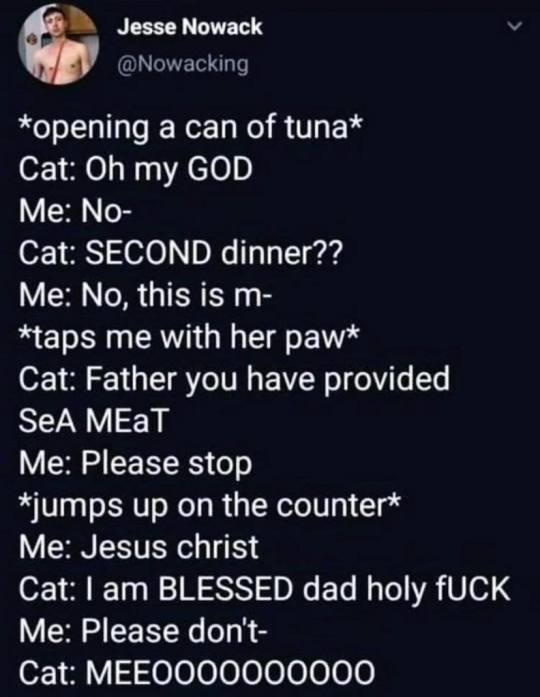
#god bless you baby not everything is about you#it’s understandable why you might think that#but the kitchen is primarily for the primates sorry#the fact that your food is also there is an unfortunate coincidence#caaaaaaats#*checks for cameras*
10K notes
·
View notes
Text
I need to talk about how orcas and giraffes are in the same order in regards to taxonomy. because WHAT. HOW. and also HUH???????


for reference. as humans our order is primates. e.g. chimpanzees. makes sense right? forward facing eyes. omnivores. hair covering our bodies. fingers for grasping. large brains. it MAKES SENSE.
and then you have the order of artiodactyla. this order includes deer, giraffes, bison, sheep, goats, cattle, etc. again, makes sense right? cloven hooves. primarily herbivorous. have horns or antlers. HAVE FOUR LEGS. but SOMEHOW. orcas (alongside whales, dolphins, etc) are ALSO PART OF THIS GROUP?!?!????? the carnivorous entirely aquatic smooth as hell extremely intelligent school bus sized legless marine predator?????????


????????????????? WHAT THE FUCK. I'm extremely upset. I love zoology. sorry one extra fun fact before you go. cows are more closely related to whales than they are to horses.
#zoology#ungulates#artiodactyla#so basically artiodactyls are even toed ungulates. e.g. goats have cloven hooves so they stand on 2 toes per foot. even toed.#whales and orcas and dolphins and porpoises etc are ALSO even toed. if you look at their skeletons they still have digits in their flippers#THIS SUUUUCKS I LOVE ZOOLOGY THIS IS STUPID IM SO EXCITED TO KEEP STUDYING IT. WHAT THE FUCK
1K notes
·
View notes
Text

Colugo
Also known as the "flying lemur" (though it’s neither a lemur nor a true flyer). Found in the lush forests of Southeast Asia, these fascinating creatures can glide up to 150 meters between trees thanks to their large flaps of skin. They’re primarily nocturnal, feasting on leaves, fruits, and flowers.
✨ Fun Fact: Despite their name, colugos are more closely related to primates than to lemurs
📷: Hendy Lie Hendy Lie
credit: 1 Minute Animals
362 notes
·
View notes
Text




How About Those Humans?
Humans, also known as human beings or people (Homo sapiens) are a species of primate found around the world. Originally from eastern Africa, the species has spread to every continent due to their remarkable adaptability to a wide variety of climates and habitats.
The primary advantage for humans comes from their complex social groups. These groups are created, and reinforced, primarily through the use of spoken and written word. Humans are the only animal known to use symbols in communication. In every part of their range, H. sapiens will form communities with other individuals- these communities are often but not always based on familial kinship; bonds can also be formed based on age, proximity, and membership to other social organizations like religion or sports. Humans have also been known to form mutualistic relationships with other such as dogs, cats, ungulates, birds, and some snakes and lizards.
People are known as one of the few species to use tools, and they do so in a highly complex manor. By use of tools, humans have been able to modify their surroundings via agriculture, architecture, and clothing; this has allowed them to expand their range well beyond the limits that their thermal tolerance and high water needs would allow. In addition, people have used their ability to manipulate tools to enhance their social relationships through the creation of ritual, music, art, craft, and sport, as well as enhancing the scale and violence of inter-group conflicts.
The appearance of humans can vary widely depending on their genetics, distribution, nutritional status, and socio-cultural group. Unlike other primates, H. sapiens are primarily bipedal, walking on their hind legs and leaving their hands free for manipulating tools. The body hair of humans is quite fine, and the skin underneath can range widely from black to white, largely as an adaptation to UV radiation. However, the hair on the top of the head can be fairly thick, and likewise varies in color and texture; it is common in many social groups to arrange and decorate the hair for aesthetic value or social status. Males and females are fairly similar in physique; males average 171 cm (5 ft 7 in) in height and 77 kg (170 lb) in weight, while females average (5 ft 3 in) and 59 kg (130 lb) respectively. Females also have more pronounced mammary glands than males.
People are omnivorous, capable of consuming many different plants and animals collected by a combination of agriculture and hunting and gathering. Depending on their region, the diet of humans may consist of different combinations of ruminants, pig, horse, dog poultry, fish, insects, milk, eggs, leafy greens, roots, fruits, berries, nuts, honey, and tree bark. Humans have no natural predators, although there are some large carnivores such as polar bears and tigers that may opportunistically hunt them.
Like other primates, humans are capable of breeding through out the year. People may form monogamous or polyandrous pairings based on socio-cultural group and individual selection. Pairings are most often heterosexual, but homosexuality is not uncommon and there is a great variety in both gender and sexual orientation, the display of which is dictated by an individual's socio-cultural group. In many cultures, courtship is initiated by the male; he may attempt to woo the female through gifts and elaborate mating displays of dance and sport. The input of immediate kin and important members of a social group can also have strong influence over the process. Selection of a suitable mate usually takes time, and a pair may court for several years before rejection. Following mating, the female carries her pregnancy for 9 months before giving birth, usually to one baby but in rare cases as many as nine.
Infants are completely dependent on external care; this is usually provided by one or both of the parents, and often extends to the entire familial or social group. Babies are typically weaned around their first birthday, at which time their diet transitions completely to solid foods. From an early age, young are incorporated into the social group via ritual, play, and teaching of skills which may come from elders in the social group or designated individuals. Though biologically H. sapiens may reach maturity as young as 13, young are typically not considered adults in their social group until the age of 18. Lifespan may vary widely based on genetic and nutritional factors, but humans are frequently known to live to be over 100.
Conservation status: Due to their wide range and large population, humans are considered stable. They have not been evaluated by the IUCN.
Happy April Fools everyone!
Photos
A Khoisan woman in Namibia by Eric Lafforgue
A Nepalese woman and child by Michal Knitl
An Armenian family and priest by Eugene Lee
A Mexican dancer by Cheryl Schweizer
#humans#people#Primates#Hominidae#hominids#higher primates#simians#primates#haplorhines#mammals#cosmopolitan fauna#cosmopolitan mammals#generalist fauna#generalist mammals#north america#central america#south america#africa#asia#oceania#animal facts#biology#zoology#ecology#happy april fools!#april fools
188 notes
·
View notes
Text
Spectember/Spectober 2024 #08: Saberatel
Roy ( @roygattero ) requested "ratel becoming the new african big predator":

Perforictis royi is the latest in the long and venerable tradition of various synapsid lineages discovering the ecological niche of "big stabby saber-teeth".
A descendant of the modern ratel/honey badger, it stands around 80cm tall at the shoulder (~2'8"), and convergently resembles the feline-like build of some of its more ancient relatives. Inhabiting the tropical forests of the rifted-off island continent of East Africa, it's an ambush predator specializing in tackling larger prey – primarily ungulates and primates, but also occasionally giant rodents and hyraxes.
Usually cooperatively hunting in mated pairs, these mustelids stalk close to their targets before attacking, with one individual focusing on toppling and immobilizing their target while the other positions itself to deliver a swift precision killing bite to the throat with its saber-teeth and powerful neck musculature.
Perforictis scent marks its territory using extremely pungent secretions from its anal pouch rubbed onto vegatation, along with making loud scream-like vocalizations.
#spectember#spectober#spectember 2024#speculative evolution#ratel#honey badger#mustelid#carnivora#mammal#art#science illustration
210 notes
·
View notes
Text
Round 3 - Mammalia - Primates

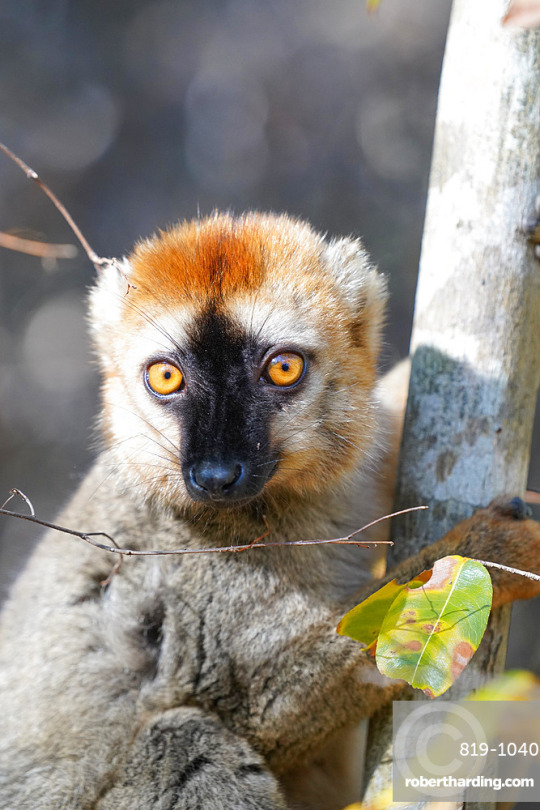

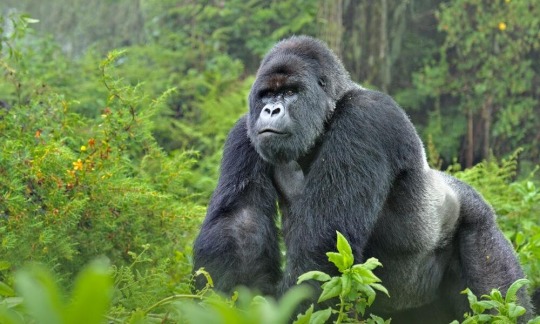
(Sources - 1, 2, 3, 4)
Our next and last group of Euarchonta is the order Primates. This diverse order includes the families Cheirogaleidae (“mouse lemurs”), Daubentoniidae (“Aye-aye”), Indriidae (“indriid lemurs”), Lemuridae (“lemurid lemurs”), Lepilemuridae (“sportive lemurs”), Galagidae (“galagos” or “bush babies”), Lorisidae (“lorises”, “pottos”, and “angwantibos”), Cercopithecidae (“old world monkeys”), Hylobatidae (“gibbons”), Hominidae (“great apes”), Callitrichidae (“marmosets” and “tamarins”), Cebidae (“capuchins” and “squirrel monkeys”), Aotidae (“night/owl monkeys”), Pitheciidae (“titis”, “saki monkeys”, and “uakaris”), Atelidae (“spider monkeys”, “howler monkeys”, and “woolly monkeys”) and Tarsiidae (“tarsiers”).
Many primate characteristics represent adaptations to an arboreal environment, including large brain sizes, binocular vision, color vision, vocalizations, shoulder girdles allowing a large degree of movement in the upper limbs, and opposable thumbs (in most but not all) that enable better grasping and dexterity. Their large brains (relative to body size) compared to other mammals, as well as an increased reliance on visual acuity, has been an evolutionary trade-off at the expense of their sense of smell (the dominant sensory system of most mammals). Most primates are arboreal, but some primates, including gorillas, humans, and baboons, are primarily ground-dwelling, though all species retain adaptations for climbing trees. Arboreal locomotion techniques include leaping from tree to tree or swinging between branches of trees (brachiation); terrestrial locomotion techniques include walking on two hindlimbs (bipedalism) or modified walking on four limbs (quadrupedalism) via knuckle-walking. They are the most cognitively advanced animals, capable of using tools. Primates may communicate using facial and hand gestures, smells, and vocalizations, with humans (genus Homo) creating complex languages and sophisticated civilizations.
Primates are among the most social of all animals, forming pairs or family groups, uni-male harems, and multi-male/multi-female groups. Primates have slower rates of development than other similarly sized mammals, reach maturity later, and have longer lifespans. Females give birth to 1-2 young at a time. In some species, male primates take part in raising young, an oddity for mammals.
Primates arose in the Early Paleocene, about 65.9 million years ago. The earliest possible primate/proto-primate may be Purgatorius, which dates back to the Early Paleocene of North America. The oldest known true primates from the fossil record date to the Late Paleocene of Africa, around 57 mya (Altiatlasius) or the Paleocene-Eocene transition in the northern continents, around 55 mya (Cantius, Donrussellia, Altanius, Plesiadapisand, Teilhardina). The suborder Strepsirrhini, which includes the lemurs, lorisids, and galagos, is generally thought to have split off from the primitive primate line about 63 mya, and evolved independently from monkeys.

Propaganda under the cut:
The smallest primate in the world is the critically endangered Madame Berthe's Mouse Lemur (Microcebus berthae), with an average body length of 9.2 cm (3.6 in) and seasonal weight around 30 g (1.1 oz).
One of the largest primates in the world is the critically endangered Eastern Gorilla (Gorilla beringei) (image 4). Males are much larger than females. A full-grown male Eastern Gorilla typically weighs 140–205.5 kg (309–453 lb) and stands 1.7 m (5.6 ft) upright and a female typically weighs 90–100 kg (200–220 lb) and stands 1.5 m (4.9 ft) tall. Some Humans (Homo sapiens) have surpassed this size, but it is not the average for Humans, for which the average adult male stands about 171 cm (5.7 ft) tall and weighs 77 kg (170 lb), while the average height for adult Human females is about 159 cm (5.3 ft) and average weight is 59 kg (130 lb).
All lemurs (superfamily Lemuroidea) are native only to the African island of Madagascar, and evolved independently from other primates on the island. The International Union for Conservation of Nature (IUCN) considers lemurs to be the world's most endangered group of mammals, noting that as of 2013 up to 90% of all lemur species face the threat of extinction in the wild within the next 20 to 25 years.
As many lemurs eat nectar as a part of their diet, and catch pollen in their fur in the process, they are considered to be some of the largest pollinators in the world. The endangered Hairy-eared Dwarf Lemur (Allocebus trichotis) has an extraordinarily long tongue. This is thought to be an adaptation for drinking nectar and tree sap. The vulnerable Red-bellied Lemur (Eulemur rubriventer) has a feathered tongue, also a likely adaptation for feeding on nectar.
The Golden Bamboo Lemur (Hapalemur aureus) eats Giant Bamboo (Cathariostachys madagascariensis), which contains high levels of cyanide. The Golden Bamboo Lemur can consume twelve times the typically lethal dose of cyanide for most mammals on a daily basis. The physiological mechanisms that protect it from cyanide poisoning are unknown.
The Aye-aye (Daubentonia madagascariensis) has evolved some insect and seed-eating traits that are unique among primates, making it stand out among the lemurs. Such traits include continuously growing rodent-like front teeth for gnawing through wood and hard seeds, a highly mobile filiform middle finger for extracting food from tiny holes, large bat-like ears for detecting hollow spaces within trees, and use of self-generated acoustical cues to forage.
Many lemur species, including the Ring-tailed Lemur (Lemur catta), Milne-Edwards' Sifaka (Propithecus edwardsi), and the Verreaux's Sifaka (Propithecus verreauxi), live in groups led by a dominant female. Lemurs are one of the very few mammal groups where females are usually dominant over males.
Some lemurs, such as the Verreaux's Sifaka, live in the spiny forests of Southern Madagascar. Sifakas travel via leaping rapidly from tree trunk to tree trunk, an ability referred to as "ricochetal leaping". It is unknown how the Verreaux's Sifaka manages to do this characteristic leaping without impaling themselves on the long thorns of the spiny forests’ trees.
The extinct Giant Sloth Lemur, Archaeoindris fontoynontii, was comparable to a gorilla in size. It was rare, but still living when humans first arrived on Madagascar. Its large size and terrestrial habits would have made it vulnerable to hunting and habitat loss.
It was previously thought that all lorisids moved slowly, but this is not the case. Lorisids freeze in place as a defense tactic, or move slowly if they see or hear a potential predator. This only works in their leafy environment, and is a form of camouflage. Many lorisids are actually quite agile when not afraid.
Slow Lorises (genus Nycticebus) (image 3) from southeast Asia produce a secretion from their brachial gland, that is licked and mixed with their saliva to form a toxin which can be used for defense. This toxic bite is a rare trait among mammals, and unique among primates. The Slender Lorises (genus Loris) from Sri Lanka and South India also possess these brachial glands, but it is uncertain whether they also synthesize the toxin.
The Gelada (Theropithecus gelada) has a diverse repertoire of vocalizations thought to be almost as complex as that of humans.
The Allen's Swamp Monkey (Allenopithecus nigroviridis) has adaptations for a partially aquatic environment, including slight webbing of its fingers and toes.
The Common Patas Monkey (Erythrocebus patas) is the fastest runner among the primates, reaching speeds of 55 km/h (34 mph). For reference the fastest human, Usain Bolt, reached 37.58 km/h (23.35 mph) during his world record sprint.
The terrestrial guenons (genus Allochrocebus) live in fairly small groups dominated by females, with only a single adult male. The females are usually related, while the male stays only a couple of weeks or at most a couple of years, working as a watchdog and breeder.
Around dawn and dusk, dominant male Campbell's Mona Monkeys (Cercopithecus campbelli) will climb up to a perch and issue a series of booming calls. The sound carries for at least a kilometre, and other males join in. Campbell's Mona Monkeys often associate with monkeys of other species and engage in inter-species territorial calling which obey certain ritual rules. This is one of the more advanced forms of animal communication, with a rudimentary syntax.
Male Crested Mona Monkeys (Cercopithecus pogonias) will sometimes join groups of unrelated monkey, such as the Black Colobus (Colobus satanas). These otherwise solitary males can form strong group bonds with the non conspecific monkeys, possibly resulting in a permanent loss of mating opportunities.
The Northern Plains Gray Langur (Semnopithecus entellus) has a symbiotic relationship with the Chital (Axis axis), and the two species are rarely found apart. Both the langur and the deer know each other’s warning calls, and benefit from both groups watching for predators in the trees and on the ground.
Nearly all (73–100%) captive Rhesus Macaques (Macaca mulatta) are carriers of the herpes B virus. This virus is harmless to macaques, but infections of humans, while rare, are potentially fatal
The endangered Crab-eating Macaque (Macaca fascicularis) is the only old world monkey known to use stone tools in their daily foraging, and they engage in robbing and bartering behavior in some tourist locations.
Dusky Leaf Monkeys (Trachypithecus obscurus), Crab-eating Macaques, and White-thighed Surilis (Presbytis siamensis), form tolerant foraging parties, with juveniles playing together.
The critically endangered Celebes Crested Macaque (Macaca nigra) unknowingly found itself at the center of controversy between 2011 and 2018, when British wildlife photographer David J. Slater set up equipment that would allow the macaques to take “selfies.” People for the Ethical Treatment of Animals (PETA) argued that Slater could not hold a copyright claim over the “monkey selfie” that resulted, as it had been taken by a macaque and not him. This resulted in the United States Copyright Office stating that works created by a non-human, such as a photograph taken by a monkey, are not copyrightable. Slater lost income and took a blow to his reputation as a wildlife photographer as a result of the dispute. In a separate dispute, PETA tried to use the monkey selfies to establish a legal precedent that animals should be declared copyright holders, requesting that the copyright be assigned to the macaque, who they decided was named “Naruto”, and that PETA be appointed to administer proceeds from the photos for the endangered species' benefit. In dismissing PETA's case, a federal district court ruled that a monkey cannot own copyright under US law. PETA appealed. In September 2017, PETA and Slater agreed to a settlement in which Slater would donate a portion of future revenues on the photographs to wildlife organizations, but the court did not accept the settlement. In April 2018, the appeals court ruled against PETA, stating in its judgement that animals cannot legally hold copyrights and expressing concern that PETA's motivations had been to promote their own interests rather than to protect the legal rights of the monkeys. The ordeal left Slater with very little funding, and he lost his motivation and passion for photography. However, he was still glad for the impact the photos had on people, stating "It has taken six years for my original intention to come true which was to highlight the plight of the monkeys and bring it to the world. No one had heard of these monkeys six years ago, they were down to the last thousands. ... The locals used to roast them, but now they love them, they call it the 'selfie monkey'. Tourists are now visiting and people see there is a longer-term benefit to the community than just shooting a monkey."
In Ancient Egyptian mythology, Babi was the deification of the Hamadryas Baboon (Papio hamadryas) and was therefore a sacred animal. They were known as attendants of Thoth, and are thus also called the Sacred Baboon.
Critically endangered Red-shanked Doucs (Pygathrix nemaeus) eat peacefully with each other, and have been known to share their food with others. They may even break pieces of foliage off and hand them to each other, a type of active generosity that is rare among Old World monkeys.
Humans, Baboons, Bonobos (Pan paniscus), and Chimpanzees (Pan troglodytes) are omnivorous hunters, and will set off on hunting parties, sometimes bringing down smaller monkey species.
Both Chimpanzees and Humans are known to wage wars over territories and resources.
Orangutans build nests for both day and night use. Nests may be elaborate and involve a foundation and mattress made by intertwining leaves and branches and adding broken leafy branches. Additional features such as shade, a waterproof roof, "pillow", and "blanket", all of which are made from branches, twigs and leaves, may also be added.
Critically endangered Bornean Orangutans (Pongo pygmaeus) have been observed using tools such as using leaves as toilet paper, a pad of leaves as a plate for holding spiny durian fruit, a leafy branch for a bee swatter, a bunch of leafy branches held together as an "umbrella" while traveling in the rain, a single stick as a backscratcher, a branch or tree trunk as a missile, and have even been sighted using spears to attempt (unsuccessfully) to catch fish.
The critically endangered Sumatran Orangutan (Pongo abelii) has been observed using a different arsenal of tools. One may break off a tree branch that is about a foot long, snap off the twigs and fray one end with its teeth. The orangutan will then use the stick to dig in tree holes for termites. They will also use the stick to poke a bee's nest wall, move it around and catch the honey. In addition, orangutans use tools to eat fruit. When the fruit of the Neesia tree ripens, its hard, ridged husk softens until it falls open. Inside are seeds that the orangutans enjoy eating, but they are surrounded by fiberglass-like hairs that are painful if eaten. A Neesia-eating orangutan will select a five-inch stick, strip off its bark, and then carefully collect the hairs with it. Once the fruit is safe, the ape will eat the seeds using the stick or its fingers. Tools are created differently for different uses. Sticks are often made longer or shorter depending on whether they will be used for insects or fruits. If a particular tool proves useful, the orangutan will often save it. Over time, they can collect entire "toolboxes".
Endangered Bonobos (Pan paniscus) are capable of altruism, compassion, empathy, kindness, patience, and sensitivity. They are known for living in matriarchal societies, having more fluid sexuality, and settling disputes with sex rather than violence.
In a study published in February 2025, scientists determined that Bonobos could tell when a Human didn't know something, and point them in the right direction.
The endangered Siamang (Symphalangus syndactylus) has a large gular sac (throat pouch) that can be inflated to the size of the gibbon’s head, allowing it to make resonating calls. Mated pairs produce loud, well-patterned calling bouts, which are referred to as duetting. These calls advertise the presence and status of a mated pair. Newly formed pairs spend more time singing than an established pair.
The critically endangered Hainan Black-crested Gibbon (Nomascus hainanus) is one of the most endangered animals in the world. The most recent count found 22 Hainan Gibbons split between two families, one family of 11 and one of 7 members, with 4 loners, all residing in Bawangling National Nature Reserve on Hainan Island. Over 25% of the Hainan Gibbon’s habitat has been reduced due to illegal pulp paper plantation growers. As there are no Hainan Gibbons in captivity, the entire population could be one major storm or epidemic away from extinction.
Tarsiers are the only entirely carnivorous living primates.
Philippine Tarsiers (Carlito syrichta) are capable of hearing frequencies as high as 91 kHz. They are also capable of vocalizations with a dominant frequency of 70 kHz.
Unlike other male primates, male Callitrichids generally provide as much parental care as females. Parental duties may include carrying, protecting, feeding, comforting, and even engaging in play behavior with the babies in a group. In some cases, such as in the Cotton-top Tamarin (Saguinus oedipus), males, particularly fathers, even show a greater involvement in caregiving than females.
White-fronted Capuchins (genus Cebus) have been observed using leaves as a cup to drink water.
Female Squirrel Monkeys (genus Saimiri) have pseudo-penises, which they use to display dominance over smaller monkeys.
White-faced Sakis (Pithecia pithecia) often mate for life, and are very devoted to their partners, strengthening their bond by grooming each other.
Atelid monkeys are most famous for their long, extremely prehensile tails. Their tails have sensitive, almost hairless, tactile pads on their undersides, and can function as a “fifth limb” while moving through the trees.
About 60% of primate species are threatened with extinction. Common threats include deforestation, forest fragmentation, monkey drives, and hunting for use in medicines, as pets, and for food. Large-scale tropical forest clearing for agriculture most threatens primates, as well as farming for palm oil.
#I know it’s tempting to downvote because humans are in here and most of us are probably of the ‘I like animals more than people’ persuasion#(though I’m here to remind you that humans are animals)#but please remember that you’re voting for your favorite animal within the group not the group as a whole#I don’t know how many times I’ll have to reword these polls to make that clear but Please#Animal Polls#Round 3#Mammalia
105 notes
·
View notes
Text
Thinking about Kamino cloning primarily as a major planetary economic driver and thus extremely A Business and how that would interact with the clones’ existence as a product and more specifically with the whole thing about Quality Control. The enforcement of interchangeability has significant value in the same way the invention of the assembly line and mass produced components have value to industry, i.e. if one part of a large & complex system stops working, you don’t have to rebuild the entire damn thing, you just replace the part.
In a biologically engineered army, that interchangeability can most advantageously manifest in:
Size (smaller range of equipment, armor, housing etc necessary)
medical compatibility (you only have to stock one blood type, organ and tissue donation availability skyrockets etc)
capability (the more you can crosstrain Jeff A to do Jeff Z’s job, the easier it is to replace Jeff Z if he bites it)
So clones that look different but are otherwise to spec in the prioritized categories would probably be fine, because getting rid of them is a loss of product and thus loss of profit.
Of course, as businesspeople, the Kaminoans want their product to seem more high-end than it actually is. So you don’t want to scrap perfectly good stock, but you DO want to make sure those fucking primates don’t act up and pop the hood on their own shitty dye job while the warranty’s still active.
Cue the Kaminoans issuing hair dye, makeup, shitty 2-dollar cosplay contact lenses etc and a bunch of random mercenaries disinterestedly instructing auditoriums of 400 cadets at a time in how to haphazardly cover up your Manufacturing Defects. Half the Mandos are like “if you want an armor painting seminar i have a fucking PhD but i haven’t taken off my helmet in front of another living person in 20 years, for this we’re pulling up the first fucking makeup tutorial that falls out of Space YouTube”.
It turns out it is much, much easier and more efficient to give clones access to Space Youtube than it is to teach them things yourself.
Cue 5 years later the Jedi roll up for pickup and not only is every single clone perfectly identical, they have achieved this via having every face BEAT, hair COIFFED, skin (tone corrected & colormatched ofc) GLOWING, contoured to the GODS,
#star war#yap yap#ofc that means whenever a natborn officer unexpectedly strolls into some area 400 clones scream and dive for the bathrooms#like I DONT HAVE MY FACE ON!!!!!!#most expensive line item on the GAR budget: replacement starships#second highest: standard issue trooper Sephora full face kit
368 notes
·
View notes
Text
Writing Notes: Why do Humans Like to Drink Alcohol?
Primates have been eating fruit for at least 24 million years.
Most primates, including chimpanzees, orangutans, and gibbons, are primarily frugivorous—fruit is the mainstay of their diet.
The ripest fruits, which are greatly preferred, contain high amounts of two ingredients: sugar and ethanol.
The “ethanol plumes” emitted by fruit might provide cues to its ripeness.
Primates, including humans, have been consuming low levels of ethanol for millions of years through ripe fruit.
Modern humans, however, live in a world that is far removed from this low level of ethanol consumption.
The ethanol levels in fruit are typically only 0.6 percent (Dudley, 2002).
Based on a reasonable set of assumptions, eating ripe fruit might yield a blood ethanol level of only 0.01 percent, far lower than the typical legal definition of drunk, which is typically 0.08 percent.
Our distant ancestors did not have the kegs of beer, bottles of wine, or flasks of whiskey that currently contain high concentrations of alcohol.
According to the frugivory by-product hypothesis, the human penchant for drinking alcohol is not an adaptation but rather is a by-product of adaptive fondness for ripe fruit (Dudley, 2002; Singh, 1985).
Alcohol not only has a distinct taste but it also has a unique odor and is often associated with the color and fragrance of ripe fruits. . . . Utilizing the odor and taste of alcohol enables the animal to predict the caloric value of a food. (Singh, 1985, p. 273)
That is, all humans have adaptations that favor the consumption of ripe fruit, but these can go awry in the modern world of artificial drinks with high alcohol content.
Indeed, alcoholism in the modern world is likely a maladaptive by-product of the overindulgence of these frugivorous adaptations.
The next time you reach for a drink, perhaps you will think of your primate ancestors having their version of a party—sitting around a tree eating ripe fruit.
Source ⚜ More: Writing Notes & References ⚜ Cocktails ⚜ Wine-tasting Writing Resources PDFs
#evolution#writing reference#writeblr#worldbuilding#literature#writers on tumblr#dark academia#spilled ink#writing prompt#creative writing#writing inspiration#writing notes#history#food#writing resources
141 notes
·
View notes
Text
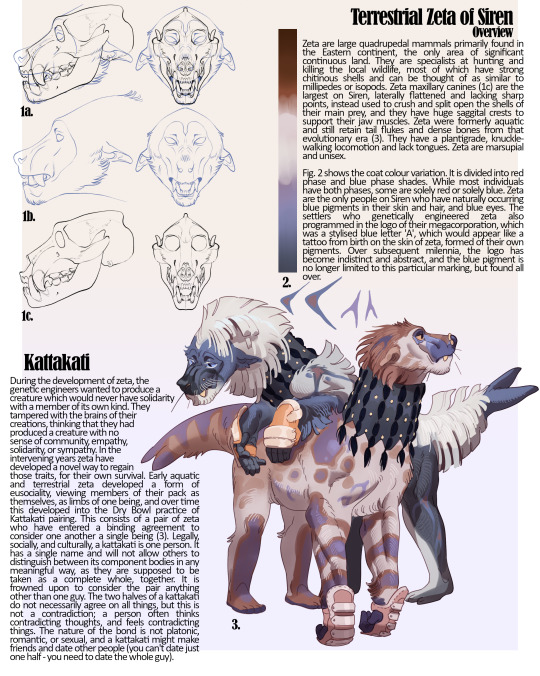
I gave up on editing and did this instead check it out. I had a rough time with the zeta because they kept getting too anthro dog-ish and I wanted them to read as primates. The one pictured there is a crew member on a whaling vessel (chef and lookout).
Image description and transcript of text below the cut:
[Figure 1 description: Front and side views of a zeta's face with the skull and external anatomy overlaid and separate. The skull is similar to a baboon's with massive broad fangs and a huge saggital crest on top for muscle attachment. Figure 2 description: a bar of colours ranging from dark brown, to reddish, to pale cream, to violet, to blue, to dark blue. Beneath it are several blue markings resembling a stylised 'A' or an arrow. Figure 3 description: a pair of zeta standing together. They are blue, brown, and cream in colour and wearing fancy black collars with dark tassels, and knuckle-guards to protect their feet. They have stocky muscular bodies and ape-like heads. One is propped up on their elbows over the back of the other, looking in a different direction.]
Text reads:
Terrestrial Zeta of Siren: Overview
Zeta are large quadrupedal mammals primarily found in the Eastern continent, the only area of significant continuous land. They are specialists at hunting and killing the local wildlife, most of which have strong chitinous shells and can be thought of as similar to millipedes or isopods. Zeta maxillary canines (1c) are the largest on Siren, laterally flattened and lacking sharp points, instead used to crush and split open the shells of their main prey, and they have huge saggital crests to support their jaw muscles. Zeta were formerly aquatic and still retain tail flukes and dense bones from that evolutionary era (3). They have a plantigrade, knuckle-walking locomotion and lack tongues. Zeta are marsupial and unisex.
Fig. 2 shows the coat colour variation. It is divided into red phase and blue phase shades. While most individuals have both phases, some are solely red or solely blue. Zeta are the only people on Siren who have naturally occurring blue pigments in their skin and hair, and blue eyes. The settlers who genetically engineered zeta also programmed in the logo of their megacorporation, which was a stylised blue letter 'A', which would appear like a tattoo from birth on the skin of zeta, formed of their own pigments. Over subsequent milennia, the logo has become indistinct and abstract, and the blue pigment is no longer limited to this particular marking, but found all over.
Kattakati
During the development of zeta, the genetic engineers wanted to produce a creature which would never have solidarity with a member of its own kind. They tampered with the brains of their creations, thinking that they had produced a creature with no sense of community, empathy, solidarity, or sympathy. In the intervening years zeta have developed a novel way to regain those traits, for their own survival. Early aquatic and terrestrial zeta developed a form of eusociality, viewing members of their pack as themselves, as limbs of one being, and over time this developed into the Dry Bowl practice of Kattakati pairing. This consists of a pair of zeta who have entered a binding agreement to consider one another a single being (3). Legally, socially, and culturally, a kattakati is one person. It has a single name and will not allow others to distinguish between its component bodies in any meaningful way, as they are supposed to be taken as a complete whole, together. It is frowned upon to consider the pair anything other than one guy. The two halves of a kattakati do not necessarily agree on all things, but this is not a contradiction; a person often thinks contradicting thoughts, and feels contradicting things. The nature of the bond is not platonic, romantic, or sexual, and a kattakati might make friends and date other people (you can't date just one half - you need to date the whole guy).
#told ya it was unethical#setting: siren#i know empathy is a charged word here but it's hard to discuss the effects of the GMO without falling back on it#they basically turned off the part of the brain that says We Live In A Society and a bunch of other stuff besides#is it scientific? no. i just wanted to explore what is necessary to reverse-engineer 'society' back into a population#speculative biology
495 notes
·
View notes
Text
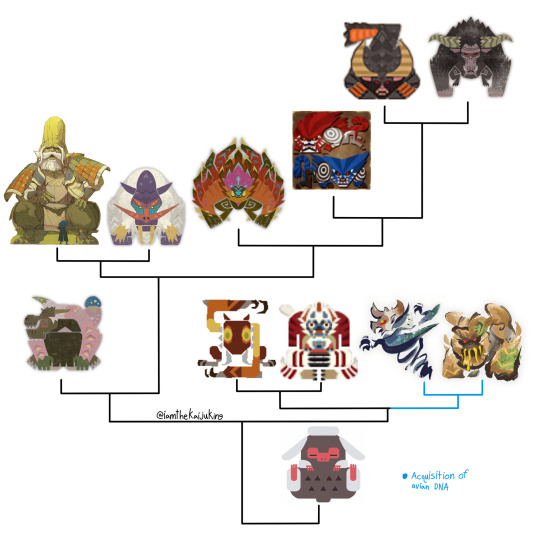
My phylogeny of the cursorial monkeys as of the release of Wilds
Gold & Pearlspring Macaque: Two species of monkey native to the hoarfrost reach.
Both species are small primates that usually take shelter in the underbrush and in caves scrounging around for small animals, and have thick fur to combat the cold. But sometimes this isn’t enough so they risk basking in hot springs to stay warm. The Pearlspring species is numerous and social, forming large family troops. The golden species is much rarer but seems to be welcomed as the Pearlspring make no efforts to drive them off.
Both species have long feet and when resting have a plantigrade leg position, but when moving they switch to digitigrade, which is a hallmark of this entire family.
Despite their appearance resembling lemurs or loris, they and by extension all members of this group are old world monkeys with close relation to the tribe Papionini (mandrills, macaques, baboons, geladas, etc). But the group itself is likely older than them.
True cursorial monkeys
Congalala: An infamously stinky species with vibrant fur.
These monkeys are somewhat social and forage together, but don’t form especially strong bonds with each other. Congas are primarily fungivores that also eat plant matter but especially fruits. They spend a lot of time digesting their hardy meals with their large and extensive digestive system which is capable of slight hind gut fermentation. Their tails are prehensile and have a padded tip for picking up food. Their mouths are especially gummy, and in fact all but the canines and incisors on their mandibles are blocked from view by their extensive gums. This gives them a slight hippo look.
For self defense Congas have large claws derived from grooming claws that can give a nasty slash and their faces and rear can flush red with blood as a warning when angry, but this pales in comparison to their other defense. The colon of the Conga is formally referred to as the Fart Chamber, and is rather large and capable of retaining waste and gas. In self defense a Conga will release the contents of its fart chamber and the foul smell and fecal matter is enough to drive away almost any attacker. There is traces of sulfur that give it a particularly strong smell and make it hard to wash out.
The iconic pink fur of Congas seems a bit odd, but is actually a vital method of anti parasitic defense. Many tropical species such as birds use bright colors in their integument as a deterrent against external parasites.
The males known as Congalala are much larger than the females and more solitary, but a Congalala usually isn’t far from a troop of Congas he’s claimed as a harem. Males have long fur on their heads that they gel into a long curved cone using the juices from the fruit they eat. This is something done to show fitness to other females, and males with bigger and more impressive cone heads are considered more attractive.
As a consequence of their more solitary lifestyle, Congalalas step up their chemical defenses. Aside from their fart chamber, they also have a small pocket in their esophagus next to the entrance of their stomach called the Burp Chamber. When eating various toxic fungi they can actually store some of the debilitating chemicals along with gas within the burp chamber to then be regurgitated at attackers.
Some particularly experienced Congalala have found ways to dye their hair as well as gel it, and these individuals have died their entire bodies a number of different colors in order to further impress females. Green is the most common but some orange individuals have been spotted.
Blangonga: An arctic species of monkey with a much more carnivorous diet.
Blango are well adapted to their environment with thick white coats that cover their bodies, except for their extremities and bald heads. They form troops to hunt as a pack to capture prey which they dispatch via their massive canines. Much like Mandrills they have distinct blue faces with snout ridges. In defense they can spew water which freezes in their cold habitats.
While most of their caloric intake is meat, Blango must occasionally consume plant matter. As monkeys they are incapable of producing vitamin C, and must gain it through food. Vitamin C is common in fruits and vegetables, but these are not common where they live, so any plants they see they will eat without hesitation to avoid scurvy. Troops may seasonally migrate during warmer periods to gorge on fruits.
Males are referred to as Blangonga and aside from size they have noticeable cranial differences from females. Their upper canines form incredibly long sabers, and they have two long bone spikes on their skulls above the canines as well as a distinct mustache growing from the cheeks. Just behind their head is also a lump of fat. These tusks, mustaches, and head boobs make them very desirable to females, and a single Male may command an entire troop of Blango. This does not mean that Blango are loyal though, as they will abandon a Blangonga that receives facial wounds that cut their mustache and breaks their tusks. These abandoned Blangonga do not survive long.
A desert subspecies exists called Copper Blangonga, which has a brown and tan coloration. They do not regurgitate water in defense as it does not freeze in their hot habitat. They’re also solitary and possibly do not possess sexual dimorphism. It’s possible that after the end of the last ice age a population of Blango became stranded in the old desert.
The dental formula of Blangonga perfectly matches with old world monkeys, with the only weird thing being that the first premolars are sharp like sideways triangular incisors. Likely an adaptation for their higher intake of meat.
Wyverians: A sapient species with long lifespans that closely resemble Homo sapiens.
It may be controversial to place them here as Wyverians hold a firm belief that they are descended from wyverns (although what kind is never specified), but a number of anatomical features say otherwise. A belly button and breasts present in many individuals firmly places them as placental mammals, and their anatomy is firmly simian. They nearly perfectly resemble humans except for their four fingered hands and feet, and the fact that they can have digitigrade legs and grow bigger than humans.
It’s these limbs that are the biggest tell as they match perfectly with the cursorial monkeys. But why lose their tails and evolve to be upright? Perhaps it could be to better free up their arms for tool use, and as they oriented their bodies vertically the tail offset their balance and was lost. Much like humans, this upright posture meant the head was held up by simply sitting on the neck vertebrae and not be held up by neck muscles that attached to the cranium. Thus allowing their brains to expand.
Many individuals can grow to astonishing size and males can become especially enormous and grow a distinctive domed head possibly composed of firm fat. The biggest known Wyverian is His Immenseness, who perfectly exemplifies these traits. These traits could perhaps be an evolutionary holdover from their sexually dimorphic ancestors who had keystone individuals in their troops.
Wyverians also live unnaturally long lifespans, rivaled only by the Actinistian elder dragons. It’s unknown why they possess such ludicrously long lives, or why it would even be necessary evolutionarily. But allow me to present a theory.
We know that many ancient civilizations have fallen in the world of monster hunter, and some especially advanced ones had access to genetic engineering. Wyverians typically inhabit the upper echelons of society or more academic spaces, with exceptions such as blacksmiths. It’s rather likely that this is a holdover from the ages long lost, and it’s not impossible that Wyverians may have gifted themselves long lives as members of the ruling class. Food for thought.
Ajarakan: A volcanic species that decorate themselves in ore that they heat up.
Ajarakan, Rajang, and their closest relatives form a family of long snouted cursorial monkeys that ancestrally dwelled in volcanic environments. This ancestor had a very high heat tolerance and consumed minerals to enable its higher degree of biomineralization than what’s standard for monsters.
Ajarakan itself deposits most of its ingested ore on its dorsal side, which form large flame-like structures. In defense they use friction via beating their tails against their backs and rubbing themselves against the ground to heat up their ore to the point of glowing with heat. They can get so hot that they melt some rocks on contact.
Ajarakan are noticeably more arboreal than their relatives, and have no trouble navigating their environment vertically. To aid this they have very specialized hair on their hands. Their palms and fingers are like those of geckos and work the same way, being covered in thousands of hairs arranged in lamellae. This structure takes advantage of Van Der Waals forces much like the feet of spiders and gives them unparalleled grip.
Ajarakan have minimal sexual dimorphism and are largely asocial, but the population native to the oilwell basin form coalitions during the firespring to look out for Nu Udra. The house sized octopodes have a particular distaste for the monkeys as they are the only native species capable of reaching and eating their eggs.
Ajarakan’s dentition on their top jaw has the same amount of teeth as old world monkeys, with 16 teeth. Standard fare, 4 incisors, 2 canines, and presumably 4 premolars and 6 molars. So a dental formula of 2.1.2.3.
The bottom jaw is a little more unusual with 4 incisors, 2 small canines grouped with the incisors, 2 premolars that have taken the role of canines, and presumably 4 more premolars and 6 molars or 2 more premolars and 8 molars. So the dental formula for the lower jaw would be 2.1.3.3. or 2.1.2.4. The grouped together incisors and canines are similar to the condition on Rajang’s upper jaw, which might indicate that the ancestors of this group had tooth combs on their top and bottom jaws, and the first premolars took over the duty of canines.
Gougarf: A magnetic species with two distinct phenotypes.
Gougarfs are monkeys that ingest ferromagnetic metals and incorporate them into their tissues and give themselves a magnetic charge.
While the species itself lacks sexual dimorphism, there are two phenotypes. The blue Rey Gougarf known for their more wolf-like face and sharp V-shaped arch of fur on their backs. And the pinkish red Lolo Gougarf which has a pushed in bulldog face and rounded mane. These two different types have opposite magnetic charges and will work together to exploit this.
The species is very poorly understood due to the fact that Mezeporta hunters don’t like hunting them.
Voljang: A sister species to Rajang with ore infused armor that resides in volcanos.
Voljang are very rare but seem to have similar abilities to Ajarakan, even using friction to heat up their bodies. They lack the electrical abilities of Rajang.
Not much else is known.
Rajang: The most infamous species on this list, many hunters have been mangled in their attempts to take down this raging monkey.
Rajang are rare and usually found in habitats with extreme temperatures. Their diet primarily consists of meat. The species is violently asocial and doesn’t have sexual dimorphism. The large horns of Rajang sit on the rear of the skull roughly where a good chunk of the temporalis muscles would normally attach, so it is likely that Rajang (and by extension Voljang) have sacrificed surface area for jaw muscle attachments for these massive horns. The horns themselves are primarily defensive with slight display purposes. The bigger the horns on a Rajang, the less other Rajang will want to mess with it.
The most famous feature of the species is their brutal strength and electricity. Rajang ingest conductive ores. Usually this is copper, but if available they prefer gold. These metals are partly stored in their muscle fibers, and the muscles in their forearms have been compared to metal. These metals both transfer the immense electrical energy they produce to different parts of their bodies, but also store some of it as well. When excited their fur glows a bright golden thanks to symbiotic microbes. Ordinarily these bacteria are hitchhikers only found in Rajang fur, but when the monkeys must defend themselves they are capable of electrogenesis and adding to the monkey’s power as a way of earning their keep. This immense electrical energy is regulated thanks to a ganglion present in the tip of the tail. If this ganglion is damaged or severed then a Rajang loses its ability to regulate its powers and its electrogenesis becomes self destructive. These individuals are known as Furious Rajang.
The disproportionate strength of the species may be possible due to their electricity. The way this electricity interacts with their muscles may grant them conscious access to hysterical strength.
Rajang have a distinct taste for the rhino Kirin, or rather their horns. The minerals and compounds present in the alicorn is vital for the monkeys to gain full access to their abilities. What precisely it is within the alicorn they need isn’t known though.
As is common among their relatives, Rajang tissues can withstand high temperatures, and when enraged a Rajang can become so hot that steam rises from it. Rajang can also flip up their upper lip like a gelada.
The dental formula of Rajang’s upper jaw is 2.1.2.3. Four incisors, two small canines grouped with the incisors (likely a remnant of a tooth comb), four canine-like premolars, and six molars with the first two being canine-like. The formula for the lower jaw is 2.1.1.3. Four incisors, two massive canine tusks, two sharp premolars similar to Blangonga’s and two missing, and six molars.
Gliding monkeys
Kecha-Wacha: A very strange and arboreal species that is a member of the other branch of the cursorial monkey family that still retain more of their arboreal origins, the gliding monkeys.
Kecha have a suite of bizarre physical features. Their large ears are very sensitive, especially to wood boring insects which they dig out with their claws. They can move their ears to cover their face, and these ears have eyespots that make them look bigger than they are to predators. These eyespots can also impress mates (although outside of mating, the species is solitary). Their eyes are huge and perfect for night vision. And their snouts form a trunk that can be aimed to shoot sticky snot at flying insects it intends to eat too.
The dentition of Kechas are just as unusual, with the dental formula being 2.1.2.2. on both jaws. Aside from having lost four molars, all of their teeth except for their canines are incisor-like. This is presumably for cracking open arthropod exoskeletons easier. Their lips are also slightly more reptilian to give themselves a bigger bite.
Their claws, aside from being useful for digging into trees, are also hooked at the tip like a sloth. This makes them excellent at clinging to and brachiating from branches without having to spend energy gripping them. Their tail hook is probably useful for the same reasons.
Kecha also have a large patagium. This is used for general fall speed deceleration and energy efficiency when leaping from tree to tree, but also has use in long distance travel. Sometimes Kecha climb to the highest point in their environment to leap off and catch wind currents to extend their glide. This is much more efficient than simply walking towards a new location.
A subspecies called Ash Kecha-Wacha exists that spends more time on the ground digging for insects in the dirt. Due to their lesser reliance on trees for protection, they’re capable of spewing fire at potential predators.
Gogomoa: A sloth-like relative to Kecha with silk abilities.
Gogomoa are perhaps the most arboreal of the cursorial monkeys as they are incredibly awkward on the ground. Their hands have lost a lot of their dexterity to converge strongly on that of a sloth and they spend most of their time upside down in the trees. Gogomoa have a highly reduced but noticeable patagium that in the past would have let them glide like their relatives, but seems to have been traded for their most unique feature.
These monkeys can produce silk from their palms. Silk production is generally not an unusual thing to evolve as it’s everywhere in the animal kingdom, but it’s unheard of in vertebrates, much less a mammal. This is especially paradoxical as mammals cannot produce beta keratin, the type of keratin famously absent in all vertebrates except in diapsids and what feathers are made of. But beta keratin is also present in fibroin, a component of silk. It thus would stand to reason that Gogomoa might have not evolved this on their own, but rather acquired the genes for beta keratin and silk production via a horizontal gene transfer event. And considering the other members of the gliding monkey family, this would not be the first time.
This silk is used for brachiation and nest making.
Gogomoa invest quite a bit in their young as is expected of a primate. They typically produce one baby at a time, and this baby clings to their mother’s back.
Bishaten: A trouble making species with many bizarre traits.
Bishaten are tropical frugivores that have a taste for various toxic persimmons, but can fall back onto carnivory if unable to find fruit. They even evolved a pouch to carry food, although this pouch is not homologous to marsupial pouches.
The species also has a “tail hand” they can use for a variety of purposes, be it carrying things, using it as a third leg, grabbing things to hang from, or standing on it to make themselves look bigger as a threat. Bishaten also have wing-like patagiums supported by styliforms sprouting from their wrists and hips.
The most puzzling thing about Bishaten though, is their very overtly avian features. They have feathers (and by extension beta keratin), beaks (which only grow in as adults so that babies can suckle), and hips that are a mix of mammalian and dinosaurian anatomy. To call their chimeric anatomy strange is an understatement. Their acquisition of parave dna surely had to come from horizontal gene transfer, but ordinary cases of this only result in an organism gaining one or two genes, not large swaths of a genome. So there are currently two leading theories, the Retrovirus Theory and GMO Theory.
The retrovirus theory posits that an ancient retrovirus infected a bird or bird wyvern and endogenized a good chunk of its genome. The virus then made a leap to the ancestor of Bishaten and infected it. This ancestor then endogenized the contents of the retrovirus and began expressing these newly acquired genes. The issue with this theory though is that the expression of new genes would be random and not controlled, meaning that the population would have massive die offs and suffer a bottleneck due to many individuals becoming horribly mutated.
The GMO theory proposes that Bishaten were created by an ancient civilization. We know that some ancient civilizations dabbled in creating life, so it’s possible that the species is merely a feral example of this like the parave Arkveld of the forbidden lands. The issue with this is that Bishaten cannot be traced back to any particular civilization. Zoh Shia and the Dragontorch can be traced back to Wyveria, and Mi Ru and Duremudira can be traced back to the creators of the Sky Corridor and Tower. Not to mention that Bishaten is not very suitable as a beast of burden or a weapon of war.
It is still unclear which answer is correct or if they’re both wrong.
A subspecies exists called Blood Orange Bishaten that exists in more temperate and arid areas. Due to the various fruits that the blue subspecies prefers being tropical, Orangatan primarily eat the seeds present in explosive pinecones from a widespread pine tree.
Garangolm: The largest cursorial monkey and one of the three lords of the citadel.
Garangolm are massive creatures native to both temperate and tropical forests.
Garang’s relationship to Bishaten was revealed upon close anatomical inspection. They have a beak on their lower jaw and the armor on their bodies are avian scales. Their hips are similar as well and their tails have finger like projections and claws, although these are stiff and used as a plow.
Garangolm are primarily detritivores that also eat plants. The monkeys shovel large amounts of dirt into their mouths and spend most of their time digesting their meals in their big guts. Their size could be an adaptation to squeeze out more nutrients from their food as food spends more time in the guts of larger animals. Garangolm will also till the soil with their tails and cultivate their dirt and plants; farming essentially.
Their sweat is highly modified into a golden sap-like substance that promotes plant growth and can also be used to affix things to their body. There’s a debate on if this is actual sap and Garangs got the genes to make it from plants.
There is also the debate on if Garangolm is artificial as well, as it theoretically would make for great agricultural use. But Garangolm eats what it farms, which would not be desirable for humans exploiting this, and agriculture is easily done through humans and their tools already.
#monster hunter#speculative biology#speculative evolution#monsterhunter#monhun#monster hunter biology#speculative zoology#cladistics#phylogeny#phylogenetics#taxonomy#fanged beast#rajang#congalala#blangonga#kecha wacha#Bishaten#garangolm#ajarakan#wyverians
68 notes
·
View notes
Note
omg wait you study bones??? i'm a biological anthropology major and i'm very into skeletal anatomy (primarily of primates, but honestly mammalian bone structure is all very similar)...
what's your favorite bone or bone feature? :D
i'm personally very partial to the zygoma, and i'm a big fan of processes (olecranon process my beloved)
ok okay correction to everyone. i dont like study bones as a career. im a fool in an anatomy class. and by a fool i mean i have three separate liberal arts bachelors degrees and have decided to take a stem class. and well. its going about as well as one can expect.
though!!! on the way to said class i have to walk up a staircase with a handrail that looks like the olecranon process/trochlear notch area of the arm and it makes me giggle
#i want little to do with bones actually and im not going to be explaining my career plans on tumblr for obvious reasons#but i do unfortunately need to know about bones to do said career#how do i get myself in these situations i have no idea#im a history major what am i doing in bone land. i have no idea. i miss writing about the french revolution.#not a tag#from saph
95 notes
·
View notes
Text
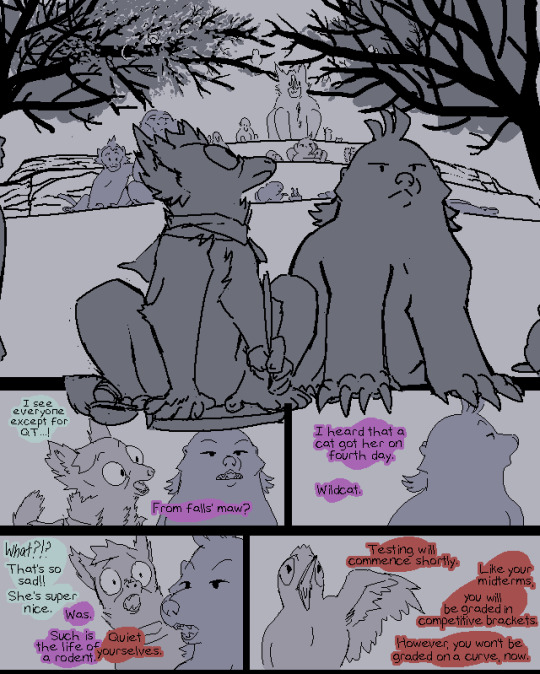
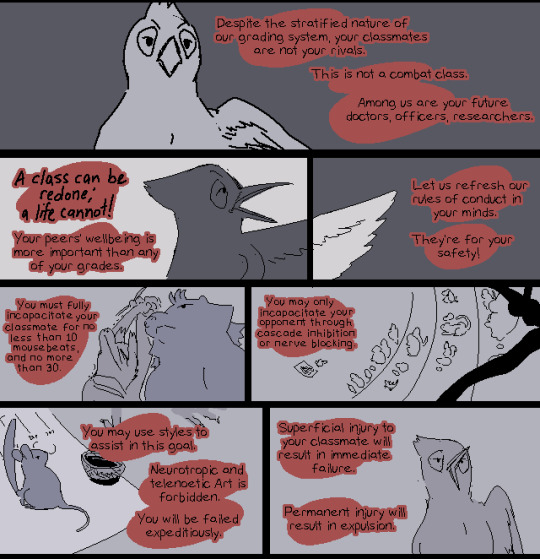
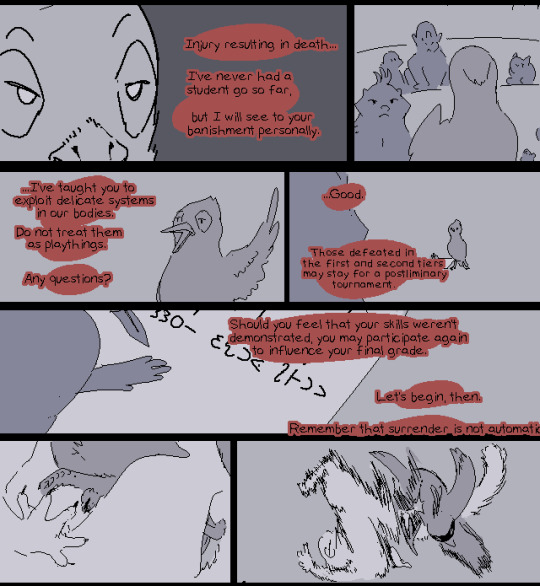
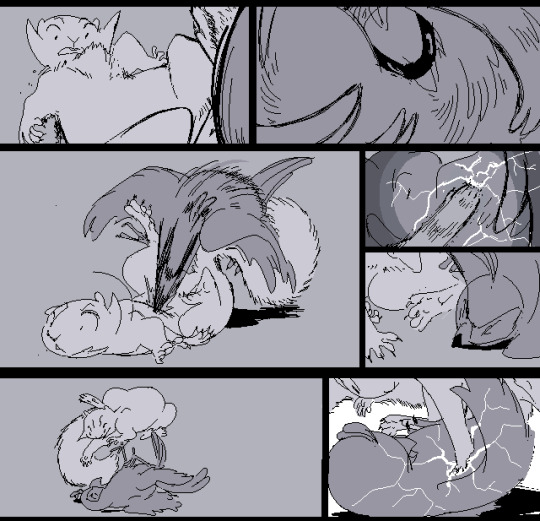
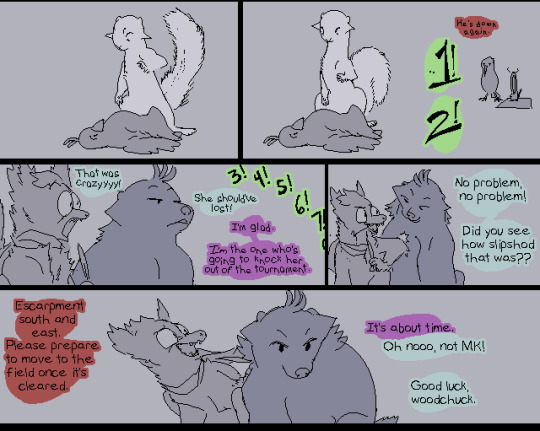
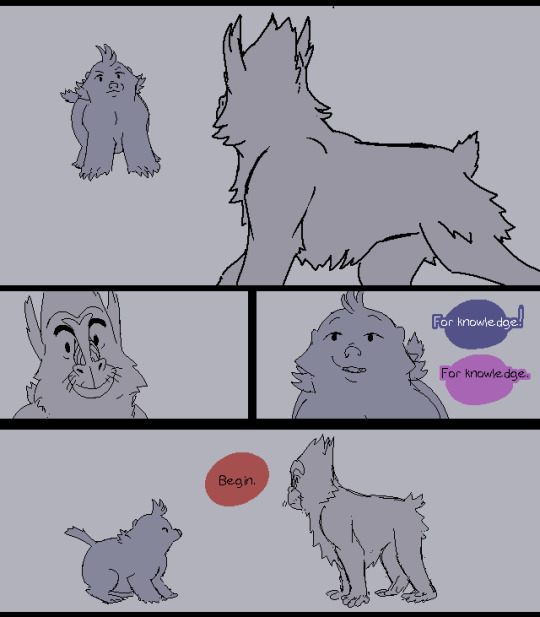
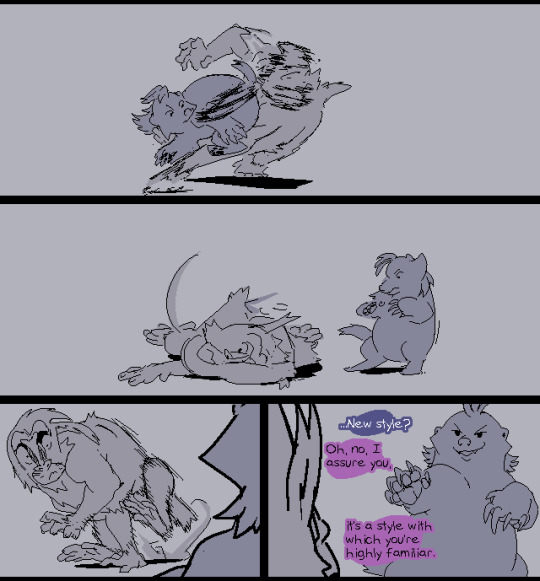
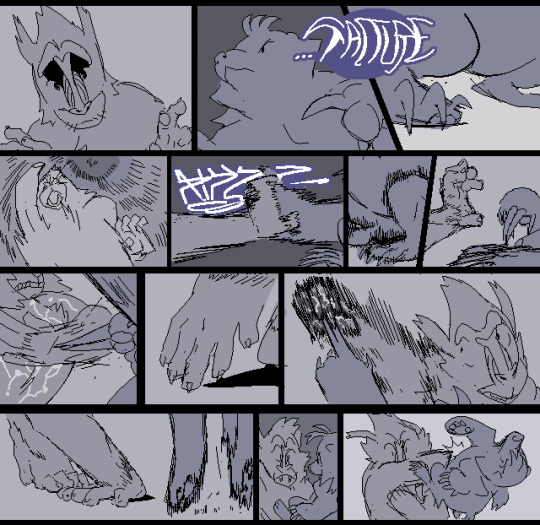
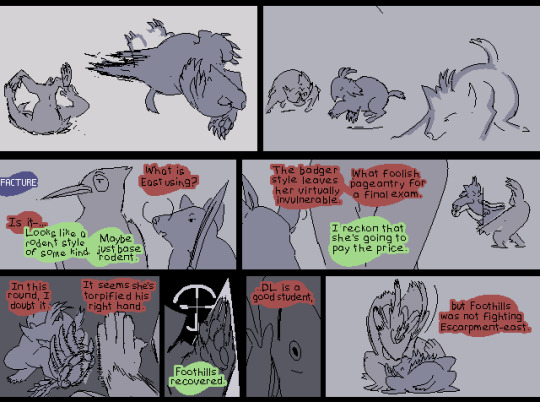
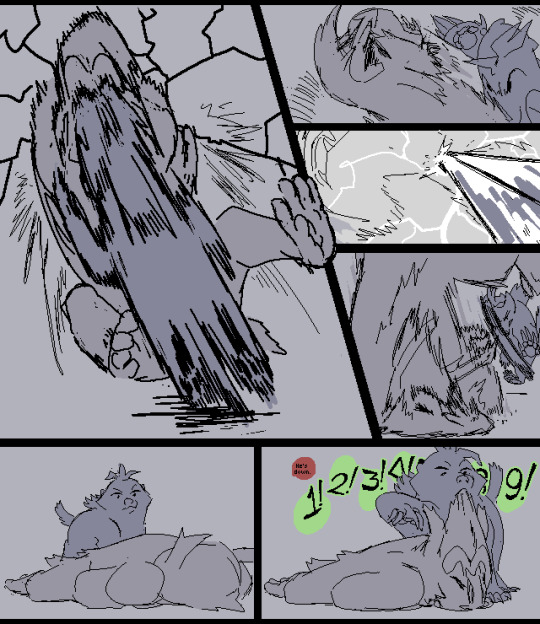
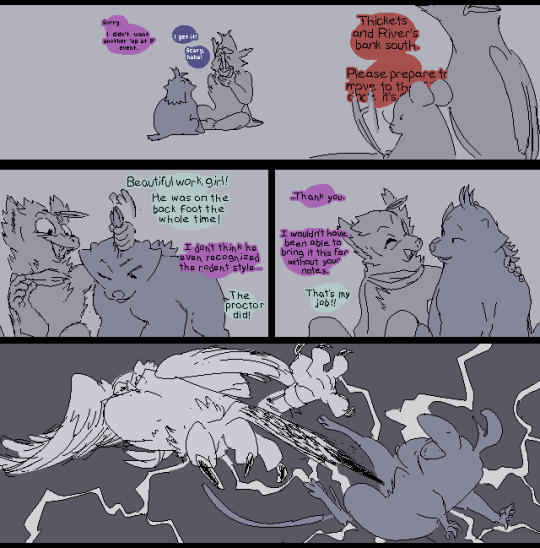
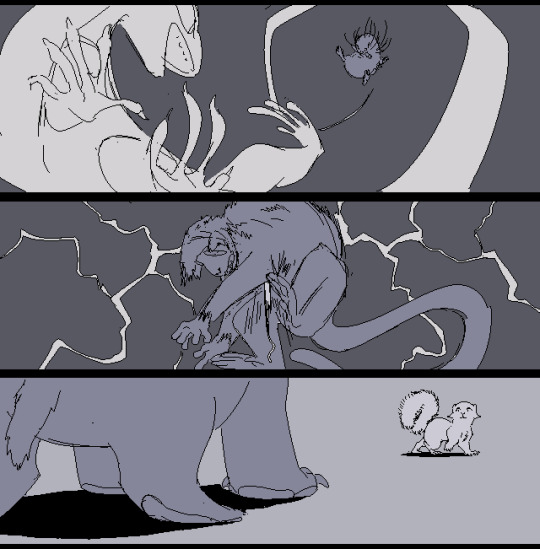
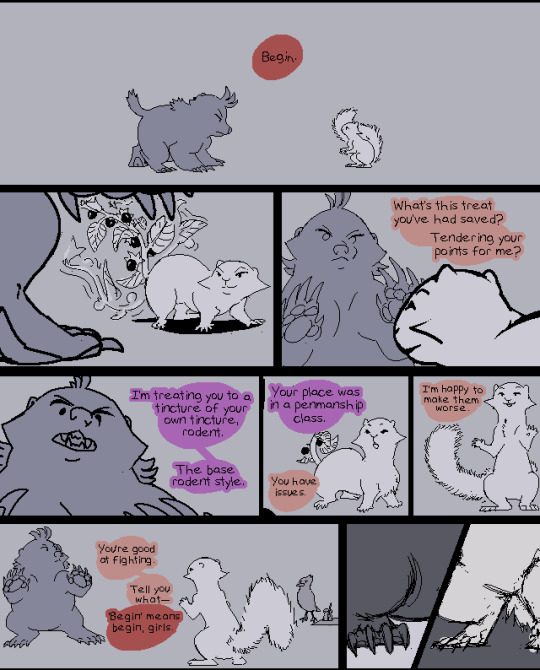
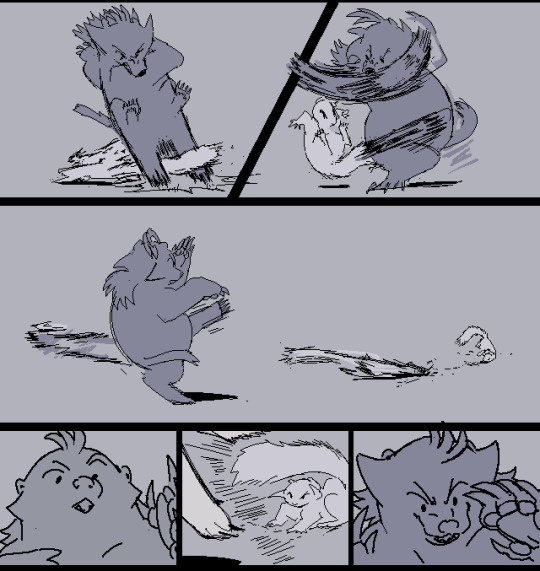
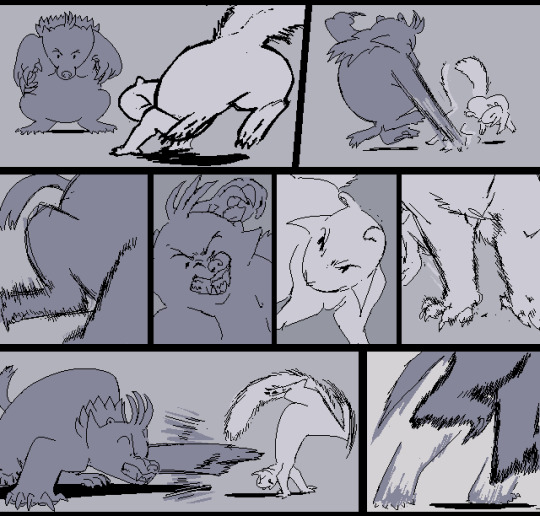
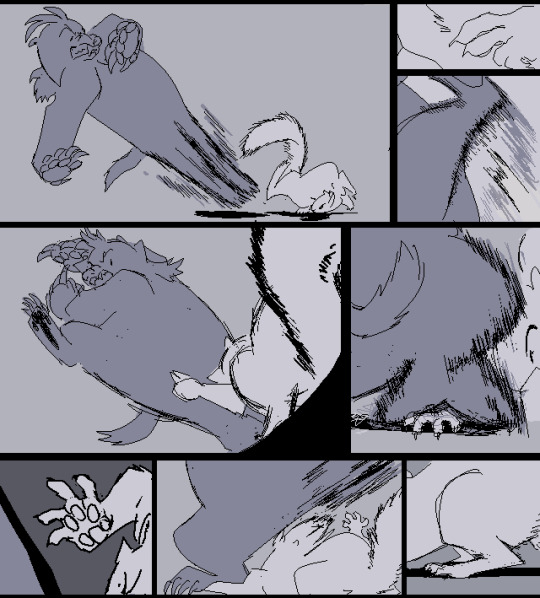
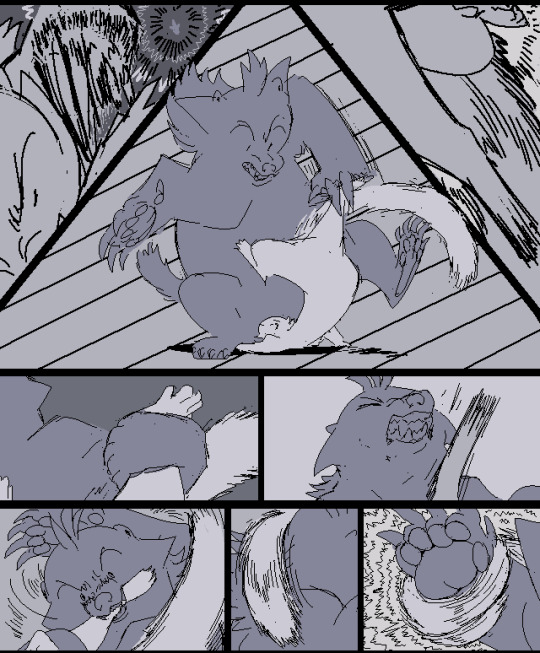
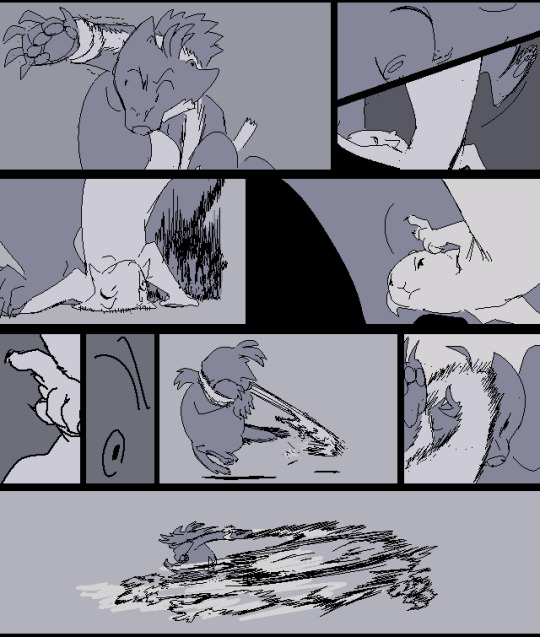
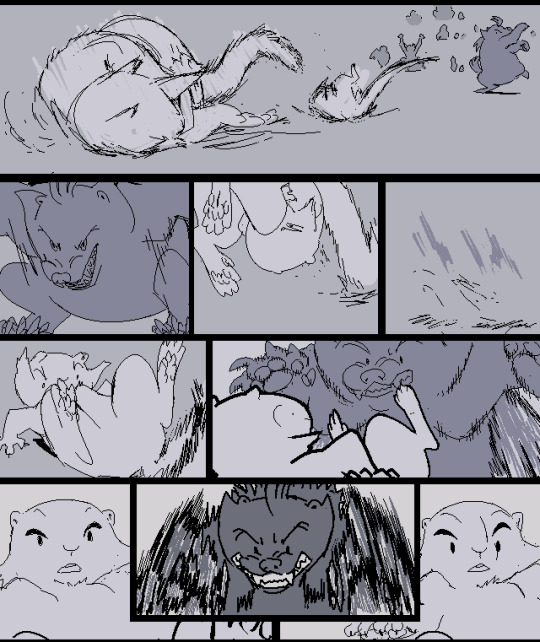
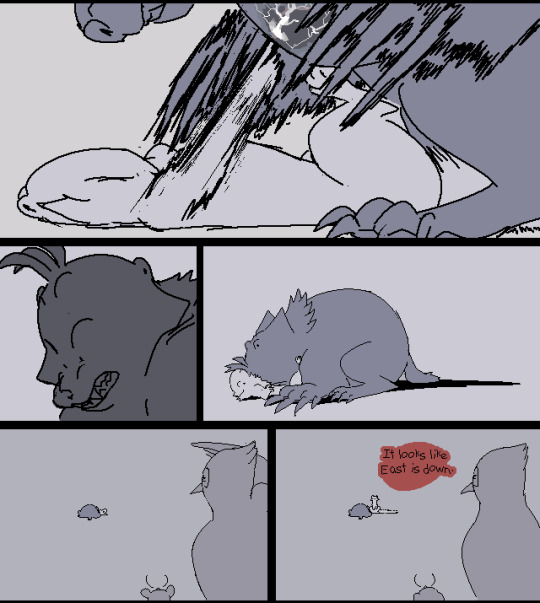
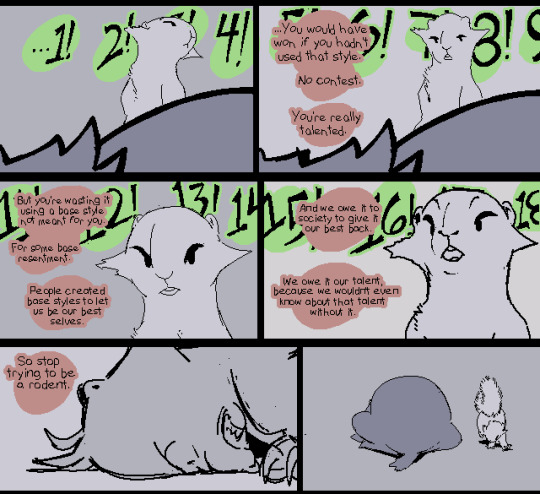
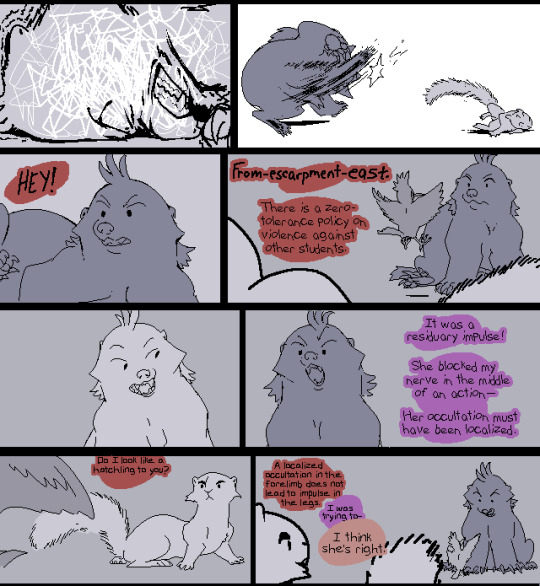
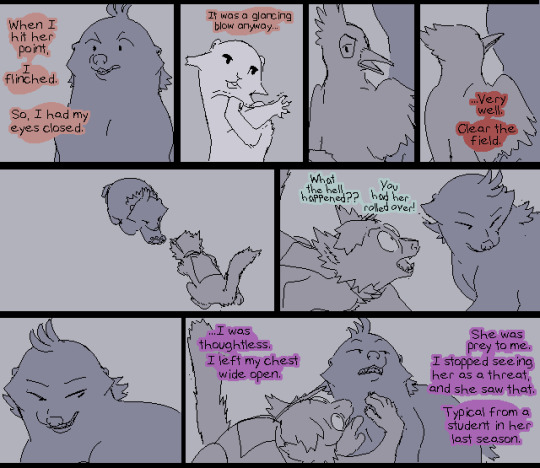
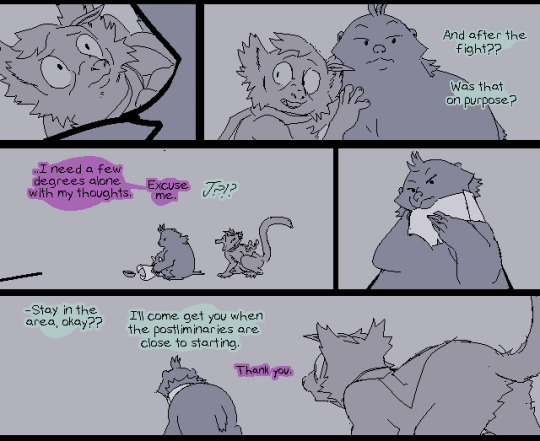
god this shit took forever to sketch. another NofNA emulation comic. it reminds me of the midterms in secretary, for obvious reasons, but Legend is sort of an inverse secretary situation, where she is exceptional at fighting, but wants to write.
let me see what i can remember...
PS, the blue-eyed black lemur, has been friends with Legend since their mutual first season at college, as mentioned above her reference sketch... they probably became more friendly after being paired up to peer edit each others' work. PS has since graduated from college and works as a markscraft. Legend frequently commissions PS to scribe for her, not only because they are friends, but because PS is one of the few markscrafts in the area who isn't a rodent. many primates go into law or medicine. mainly Legend commissions notetaking in classes -- she is too insecure to share her stories. PS has a more relaxed, informal personality, and i tried to get that across -- i think it's relevant to why she decided to become a markscraft instead of pursuing more intense study. still, i also tried to get across that they are good friends, not just scribe and customer, particularly with the amount of touching that PS does. the impulse to touch and groom is probably innate for her as a primate. there isn't as much information about her species, but in ring-tailed lemurs, lemurs usually only groom based on the strongest bonds, rather than more communal aggregate grooming as a sort of social currency. i honestly don't know what PS would need to note during finals, but i think Legend just Wanted her there anyway.
the bird, DL, fighting the squirrel, GG, is a grey shrike. i imagine him as an average student in the middle of his education, but i think he is in the class for combat purposes, because pressure point manipulation can be incredibly powerful, more so if from a less expected species like a bird.
mr. deciding is a much more serious, no-nonsense teacher, possibly due to his specialty. when you're teaching students how to explode a kidney with a handshake, you probably just play it safe and try to put the fear of god into them before any kidneys get exploded. i wanted this class to have a much heavier emphasis on safety of the participants than the class in secretary, with a more focused goal than "who can beat the shit out of each other better." i think the goal of fighting to show off knowledge here is still Fucking Insane, but it's just. their culture, i guess. you can technically "move" your pressure points, so being able to defend yourself by utilizing this knowledge can also show off what you've retained. the mouse next to him is a proctor, who is an extra teacher brought in to judge and often write for another teacher, but primarily as a peacekeeper and bouncer. in classes where a student can theoretically totally disable a teacher by just touching them once, the precaution is seen as necessary. the mouse is probably a combat-oriented point invocation instructor.
the mandrill, MK, is a first-season or first-year student -- i assume that one class, from midterms to finals, is a season, as secretary seems to start near autumn. midterms have snow, and finals are during early spring. anyway, that's tangential. i think he's very new to the educational system. i pictured him as a medical student. in his fighting style, i made him more defensive; he doesn't really know nearly as much about attacking an opponent in a fight. he does think at least about his opponent's most immediate reactions, but doesn't have enough experience with fighting to think ahead to the degree that Legend does. you can see him make the same mistake that Legend did against Machinations, which disables his non-dominant hand. needless to say, he will probably always be aware of headbutt proximity now. he attempts to use two factures in the fight within a style meant to evoke debilitating vertigo by manipulating the connection between the occular, vestibular, and proprioceptive systems. it's obvious that he created the style from his medical classes. it is fairly empty as far as styles go. interrupted facture: nystagmus, which causes the world to spin around the opponent by involuntarily twitching the eyes back and forth. second facture: strabismus, which misaligns the pupils, primarily impeding aim. denied by Legend because a honey badger does not rely on vision or a vestibular system as much as a primate does -- not something he really considered when making the style. factures that never ended up being used: pursuit, which forces the target to follow a spinning image of themselves instead of looking where they should; and mask's lasting, which forcibly initiates saccadic masking, suppressing the intake of new visual information altogether.
the large bird is a bateleur. the mouse is just a regular house mouse. the lizard is an ornate sandveld lizard. the opponent of the lizard is a common mole-rat, also called an african mole-rat (even though most species of mole-rats live in africa). the monkey god i'm not super sure but i believe it's just a vervet monkey. the other mouse is also a common house mouse.
GG is a second-year student, which is the last year for a rodent. i think she's been kind of aimless -- she thinks incredibly fast as a squirrel, and finds solving problems in the moment to be a much more successful endeavor than trying to plan ahead. she doesn't worry about the future and doesn't ruminate on the past much. she's aware that she isn't the best ever and doesn't apply herself as much as others, but it also doesn't particularly bother her. kind of ironic, given the aesop she slops onto Legend after the fight. i imagine that she will eventually choose the name Serendipity. i tried to write her lack of foresight, but compensatory quick thinking in both fights. like the shrike, GG is a combat-oriented student. the style she briefly introduces at the beginning is called fanciful flower's delightful blight. it is based on the deadly nightshade flower and its berries -- which are toxic, obviously, and a hallucinogenic. squirrels flick their tails for many reasons, and the most common reason is simply a default flicking to attract predators. their tails are designed to "deglove" easily; if a predator lunges for their tail, which is the moving part of them, the skin and fur will tear off, and the squirrel can escape. delightful blight utilizes the attention-grabbing flicking of the squirrel's tail as a nightshade plant to induce a trance-like state. the berries represent temptations so much more pleasing than what you ought to focus on. a nice berry and a flower to smell are so much nicer than struggling in a fight. even when you resist them, they linger in your mind, and "plant seeds" when the berry falls as self-restraint is worn down over repeated abstinence from the temptation. factures induce hallucinations and nausea. she primarily uses the base rodent style to fight Legend here, but also uses base squirrel style twists, which include more acrobatics, backflipping, and contortions.
the two things that really catch Legend off-guard use limbs that she doesn't have, and most opponents don't have -- elbows long enough to use defensively, and a long, rope-like tail. she is otherwise supposed to be fairly adept at analyzing what an opponent will do, usually a few steps ahead, related to her ability to fabricate narratives quickly. you can see her also come up with a lie for kicking GG fairly quickly... she was going to say the impulse was in her legs because she was trying to move away from GG's strike.
anyway if any part of this fight is like... unfathomable i can probably explain. i've already been typing for way too long, lmfao
#nofna shitposting#partaking in the act#basically legend left her chest open because she expected GG to attempt to block#instead of considering that GG could take an offensive action instead
177 notes
·
View notes
Text

Behold the Panamanian night monkey (Aotus zonalis)! Also known as the owl monkey, this pint-sized primate weighs up to 2 lbs (0.9 kg) and can be found in parts of Panama and Colombia. Actively primarily at night, especially around dusk and dawn, this critter uses its huge eyes to forage for food. Its diet includes flowers, nectar, leaves, and insects. It’s a monogamous primate, and mating pairs can remain together for life.
Photo: roylesafaris, CC BY-NC 4.0, iNaturalist
credit: American Museum of Natural History
74 notes
·
View notes
Note
I had an idea for the goblins of my urban fantasy world and I like to share it and see if it sounds any good? That idea being of having goblins be pest animals and not an actual sapient race. Having them play off the fairy tale and modern fantasy idea of goblins being mischievous pest/low level trash mobs by making them be literal pest animals
Goblins in my urban fantasy realm are animals, closely related to bats yet have intelligence closer to primates. They’re smart enough to create complex tools, weapons and structures and frequently scavenge/steal human trinkets to repurpose for their own usage. All known species are nocturnal and form large colonies that reproduce rapidly, though the exact social structure depends on the species. All human civilization (my world runs off Shadowrun/ Dungeon Meshi logic that all the humanoid races elves/ dwarves/ orcs/ etc… are collectively referred to as “human”) see goblins as dangerous and destructive pest.
As a pest animal goblins are like a horrifying combination of rats and monkeys that are smart enough to wield scavenged pocket knifes. They regularly scavenge human trash/ steal food and trinkets/ full blown rob people with makeshift weapons/ infesting and destroying homes/ and generally causing chaos wherever they go. It’s not to uncommon for people to find a goblin colony nesting in their attic or infesting abandoned buildings, often becoming a danger for urban explorers.
Okay, so, the first problem I see here is that you're trying to make goblins pest animals while still giving them people-level capabilities with the complex crafting skills. It's fine for animals to build their own structures, we know birds, insects, and rodents are all capable of making some pretty complex homes for themselves. But complex tools and weapons do kind of cross a line, in my opinion.
The fact they also actively plan and execute what sound like muggings and home robberies also doesn't help. Real life monkeys that are used to humans may get bold enough to snatch things out of people's hands or pockets, but it is primarily an action of curiosity. Your goblins feel like they cross the line away from "pest animal" and into "early stage humanoid sapience" with all these more "advanced" people treating them like trash, which is uncomfortable.
I think if you're going to make this work with goblins as pest animals, you have to take it down a few notches on their tool crafting and thievery. Maybe remove that skill altogether. I don't know what your plan was for their home structures, but make sure it doesn't end up looking like anything people would make, because I can easily see it turning into "basically a homeless camp" if they're good at using found objects to build up shelters between buildings and such. And you really don't want your "pest animal" goblins to come across as evil little homeless folk out to rob the city blind and attacking everyone they meet. Which is a little bit how they read in your current description. It's a city, so they shouldn't need to do too much to make their own shelters. Nothing more than nest piles in back alleys, or on rooftops, etc. They're already surrounded by structure, they won't need to add much to it to make it comfortable for themselves.
I would suggest going for more of a raccoon angle with their intelligence and thieving. Their primary intention should be to find food and their boldness in approaching people should be from the urbanization of the environment. Maybe even show some wild goblins outside the city who live in the trees and aren't so used to people. They'd be more inclined to run off instead of approaching anyone. And instead of crafted weapons, your goblins should only attack with their natural ones, and only if they're provoked, or desperate. Since they've become so accustomed to people, they will be bold enough to walk right up and start grabbing food they find even if someone is holding that food, but they should still show some hesitance and fear, preferring to run first and attack as a last resort, as most animals do. The may even sneak into houses, but make sure they're not actively picking locks. Opening unlocked doors may be feasible though, a lot of animals are capable of messing with door handles.
All of that should help bring them down from too-people-like to actual pest animals, and it won't take away from the danger they present to the people of the city. Good luck with your project! It sounds like a fun one!
22 notes
·
View notes
Text
THE GREAT MONSTER HUNTER RANKING! Part 7
I'll be upfront, mammals aren't really my thing when it comes to monster design. It seems that when it happens, creature designers always default to the same primates/canines/felines/ursids or what not. An argument could be made about reptiles having the same issue, but you know, personal biases. HOWEVER, that doesn't mean they CAN'T be cool. And this franchise knows (most of the time) exactly how to do that. We're looking at the mammals...and the Wyverns that look like mammals!
Before we go on, I will say that there are certain sub-categories of mammal monster in this world. I'll be starting with the most popular of them...because it's a sad fact of life that we as a species are somewhat narcissistic. So OF COURSE the beasts based on monkeys and apes get a lot of popularity. Eh, at least they're neat.
The Primate Fanged Beasts:

"Please laugh."
We're not exactly to a dignified start here. The Congalala and its smaller Conga followers look like a cartoon character as opposed to anything you'd expect from these games. They're big pink gorillas with the heads of hippos...and they fight primarily by farting. Yes, this deadly razor-clawed combo of some very powerful African animals fights by eating mushrooms and producing enough flatulence to warrant deodorant should it hit.
It...bears mentioning that gorillas in real-life do indeed fart a lot. Perhaps Capcom was on to something. But it doesn't make for an appealing monster. This thing is like a bad joke they couldn't stop telling. And its STILL able to throttle hunters with its aforementioned gross-out humor and razor-sharp talons. Bleh. 4/10.

"What? Were you expecting a yeti or something?"
In contrast with its predecessor, the Blangonga and its troop of Blangos fairs far better on the eyes and during a fight. Despite its heft, this baboon-gorilla is exceptionally agile, and can run circles around you while its underlings harass you. However, should you break its fangs, the Blangos will abandon their leader, as big fangs are considered a major sign of power amongst these monkeys. That's really neat! But aside form that, they're really just big baboons and that's it. Neat baboons, but still. 6/10.

"And this is to go EVEN FURTHER BEYOND!"
The Rajang is by and large the most feared Fanged Beast, and one of the most feared monsters period, that this world has to offer. I know I say that a lot, but it's pretty amazing how those so-called Elder Dragons keep getting shown up by supposedly lesser monsters that won't settle for waiting until the old-timers are gone. Raj here is already an intimidating sight, being a large gorilla-baboon with huge horns that make it look almost like a minotaur. But then it gets mad and/or takes a bite out of the horn of the Kirin (its favorite food). Then, it lights up with brilliant yellow stripes, lightning crackles all over its body, and before you know it, you're facing an honest-to-God Super Saiyan, complete with fists that hit so hard they superheat and release steam as they glow an angry red. Oh, and it can fire beams of lightning from its mouth too. But like a Saiyan, you can remove this amazing power by severing the tail (unless you're fighting a Furious Rajang, which has no tail but remains super anyway because screw the rules). The only thing that keeps this whole affair from being an unfair fight is that the Rajang has low health by its rank's standards. Plus, its armor set is based on the very being that inspired Toriyama all those years ago: the legendary Monkey King called Sun Wukong.
Gotta say, go monkey, go. 8.5/10.

"What good is a fight if it isn't fun?"
Just when you thought Primate Fanged Beasts were going to get old really fast, in swings the Kecha Wacha! First of all, just look at this and tell me it isn't the weirdest and the most charming of the monkey crew we got going on here. It's got the body of a monkey, the coloration of a fox, the face of an elephant, and the flaps of a flying squirrel to glide with. It's also got some wicked talons to swipe at you with, and its big ears can cover its face to make it look like it's wearing an intimidating mask. There's just so much personality and creativity in this design! It makes me want to see more of it in future games, and why we haven't seen that remains a mystery to me. 9/10

"I like to move it, move it! You like to beat it, beat it!"
The Kecha Wacha was an amazingly unique primate, but so too is the Bishaten. Personally, I see this beast as more of a giant lemur as opposed to a traditional ape. Though really, there's nothing quite like this beaked, winged, crafty, beautifully colored simian! You might have noticed, but one of its more striking features is the hand-like tail it has that it can use to rear up and hit even harder than before...or get a better aim. You see, the Bishaten fights not just with fast reflexes and raw strength. It stores a lot of special fruit in its chest pouch, which it can then chuck at foes. These include fruits that flashblind and fruits that inflict poison. Though should the monkey be knocked back down to the ground, it will drop not just these fruits for the hunter to use instead, but also healing fruits. It makes for a fun fight, against an already fun monster. I should also note that the Yokai this Rise monster is based on is the Tengu, a being said to be like a bird-man, and oftentimes malicious and/or devious. I was hoping they'd make a Flying Wyvern out of the Tengu myth, but this works just as well! 8/10.

"My body is literally a temple."
The Garangolm is...kind of underwhelming. It's dubbed one of the Three Lords of the MH:R Sunbreak expansion, and it admittedly has the power to back that up. It looks like and is built like a living castle, and while it doesn't usually attack people, it can destroy opponents with the ability to cover its arms in gauntlets of either magma or the moss it shares a symbiotic relationship with. The result is a lot of pain, and the ground being uprooted at all times. I should also note that it's specifically based on the mythological golem, or being made of materials like clay. That, or Frankenstein's Monster (which is technically a golem). But in terms of design and execution, I can't help but feel that Garangolm is a little derivative. It's just a big gorilla with armor. Not much more, not much less. 6/10.
Pop quiz, what's the scariest mammal you can picture that isn't a big cat? If you guessed bears, you'd be absolutely correct. However, because this a world where suped-up dinosaurs and living dragons exist, the mighty bear finds itself more than a bit outclassed, and thus most of these Fanged Beasts occupy the bottom end of the danger totem pole. That doesn't mean you underestimate them totally, though!
The Ursid Fanged Beasts:
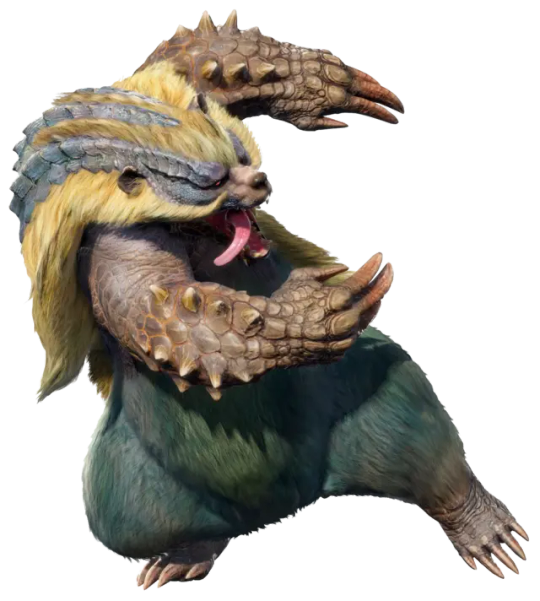
"Oh bother, I'm going to have to gut you for touching my honey pot."
Again, monster bears are some of the least of our problems in these parts. That's how ruthless this ecosystem can be. But that won't stop the Arzuros from trying to beat you down for daring it interrupt its feeding on its favorite snack, honey. In fact, should you have some honey to put on the ground, it'll drop everything its doing to dig in. Amusing, but I'd like to say that even as a monster meant to get bodied by beginners, it's not bad. It's basically a giant bear, but it's got pretty colors, and its arms look like they've got spiked braces on them. A bear of character, this one is. 7/10.
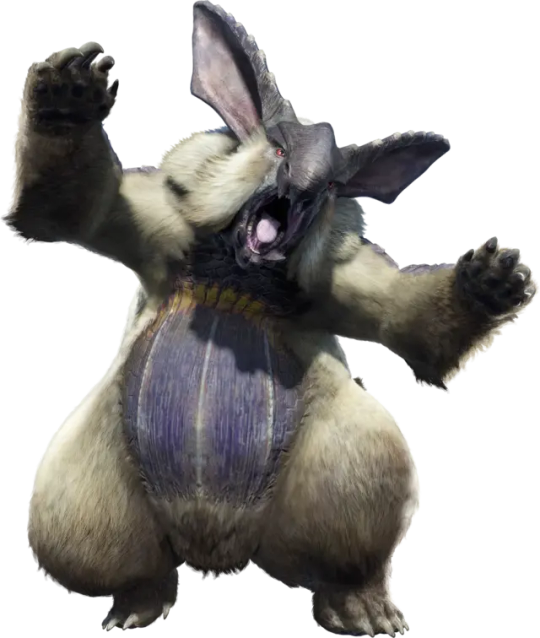
"BIG, BIG, BIG CHU-no."
Although its one of the three bears that kickstarted the Ursid line in the first place, the Lagombi looks more like a giant rabbit that slides around hitting everything with its momentum, or just flinging huge snowballs at foes. Of note in its design is how its face looks like an armored version or a wombat, or even the wombat's giant prehistoric ancestor, the Diprotodon. It's a very unique beast, and for that it already deserves a spot above its simple bear predecessor. 7.5/10.
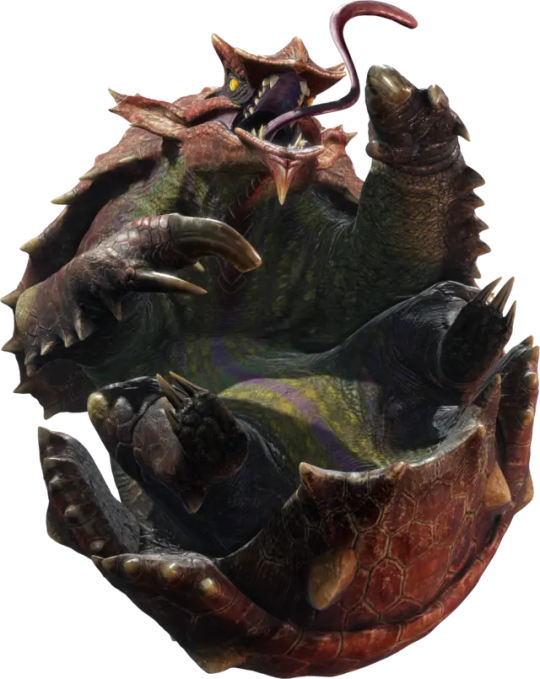
"Rollin', rollin', shockin'"
The last in the bear trio, the Volvidon all but drops the ursid look in favor of being basically a crocodile-armadillo. That's cool! And yes, it can roll around and hit you as a big ball. Oh, and it also has a long tongue that it can use to whip you, saliva that paralyzes you, and...the ability to fart really hard so that you need a deodorant. Not again. Well, at least this one sports a more dignified and vividly weird design than Mr. Pinkie McFartsalot from way earlier. So much so that I'll let it completely slide. 7.5/10.

"Now bears are REALLY bad news!"
Out of all the bears that came before and even those that might be still to come, none are quite as big of a threat as the Goss Harag. To give you an idea of how intimidating this big ursine is, it was based explicitly off the Namahage, a Japanese bogeyman that lives in the mountains, wears a scary hannya mask, and wields knives to eat up misbehaving children. The Goss Harag fits that description near-perfectly. EVEN THE KNIFE BIT. This is because it can suck up cold air and expel it so that it either freezes prey or, failing that, instantly harden upon hitting itself, turning most of the time into a huge icy knife. And this monster is intelligent enough to use it well. To add to the demon motif, it spends a lot of combat on its hind legs, and its skin can turn a furious red whenever it gets really steamed.
I'm calling it, this is the best Ursid around for being a major love letter to Japanese folklore and just being so darned unique. 8.5/10.
We come to the end of our exclusive furry club, but at this point, the monsters get harder to sub-categorize. So, here are the mammals that are neither primate or bear.
The Other Fanged Beasts:

"THEY CALL ME, MI-STAR PIG!!!"
The Bulldrome is a giant boar. That's really all there is to it. Granted, giant boars are no joking matter, even with the normally docile Bullfangos that this monster is a bigger version of. But other than having that wild haircut and a way bigger right tusk, there's not much I can say. If you really like pigs, this is your guy, I guess. 5/10.
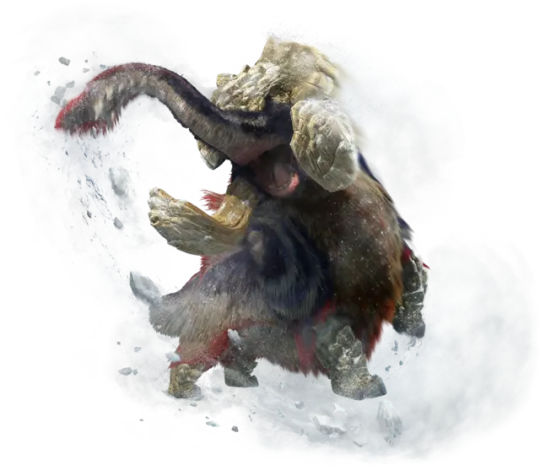
"Everyone's taking the L-ephant"
The last of the Fated Four I'll be covering, and sadly one of the most underutilized. You look at the others and you find that they've at least gotten some time to shine in the recent games. Not poor Gammoth. For some reason, this huge pachyderm has been shafted again and again. And to be fair, I kind of understand why. This elephant is HUGE, one of the biggest large monsters around. It's nowhere near as fast as its peers, it takes up a lot of arena space, and the strategy to fight it begins and ends with hitting its legs until it falls over. But while all of that doesn't make for the most engaging fight, that doesn't mean Gammoth is a bad monster. In fact, it's a great one! Capcom went all out with designing a huge fantastical Woolly Mammoth, giving it a really appealing color scheme of reds and blues, as well as a rather striking piece of head armor. And if you do some digging, you'll find that this beast is every bit as honorable as most real-life elephants tend to be. It is said to sometimes live alongside herds of Popo, and valiantly protect them from its most hated enemy, the Tigrex. Also, every Gammoth we've seen so far is female, a nod to how elephant herds are led by a matriarch. Also, its theme music is appropriately grandoise and heavy-feeling. Love it! 8.5/10.

"Please stop calling me a four-legged dumpling."
Our last Fanged Beast is a small one. The Bombadgy are the only major new small monsters in Rise, and they're kinda gross-looking and pitiful. Look at that! It's the size of a beach ball and just as bouncy. And they explode. Yes, the gasses within the very appropriately named Bombadgy are so volatile that if you were to hit it, it will go flying in whatever direction you're facing, and deflate with the force of a bomb. Such absurdity is befitting of a creature based on the Tanuki, a Yokai that looks like a crafty racoon dog with...rather gifted lower regions. In fact, a Bombadgy sitting down kinda makes it look like...that. What a sad weirdo. 5.5/10.
And that's the Fanged Beasts!
Now, we come to a very interesting category. Initially, only one was in it, and it quickly rose to fame in a heartbeat. Now, there are several, and at first it may seem odd as to HOW they're organized. Some look like mammals, but then some don't. Well, there's actually a simple explanation for that. These creatures are, in my opinion, Synapsids. That means mammal-like reptile, and it refers to a bunch of prehistoric creatures primarily from the Paleozoic Era that looked reptilian, but also have very distinctly mammalian characteristics. Thus, these Wyverns fit snugly into that description. So without further ado...
The Fanged Wyverns:

"Don't lie, you're thinking of the music right now."
Some might say that the Zinogre is an overrated monster. But in my eyes, it earned the reputation it has. It's a giant wolf, already the mark of something that will have mass appeal, but it's also huge, has gauntlet-like fists with huge blades for claws, a vibrant color scheme, and a wide tail like that of mutant beaver. But Zinogre's true power resides in its symbiotic relationship with Fulgurbugs, small insects that can generate obscene amounts of electricity. Living within small cavities in the monster's horns and spikes, the bugs in exchange give the Zinogre the ability to channel electricity into its attacks for devastating damage. And this is on top of hitting hard with moves that make it almost look like its breakdancing. Such spectacle and biological wonder make for a monster that does indeed represent what makes these beasts so fascinating. And on top of that, it's well-known for having a theme that incorporates an electric guitar on top of traditional eastern instruments (there was a version of this theme on Youtube that combined the MHW:I and MH:R themes, but I can't find it). 9/10.

"GIT IN MAH BELLEH!"
A lot of people have bullied the Great Jagras for being a starter monster that gets its ass kicked by just about everything. But I find myself rather charmed by it. It's basically a giant iguana, but I don't mind the simplicity. It being an iguana brings to mind the Slurpasaurs of those old 50s movies that used iguanas to substitute for dinosaurs. That, and it just makes me think of the monster-sona of Shaggy from Scooby-Doo, right down to having the same voracious appetite. Oh yeah, it can swallow large herbivores whole. Still, I like this monster for what it is. 8.5/10.

"I'm a snaaake."
The Great Girros isn't quite as charming as the Jagras, but I still think people are needlessly mean to it. It's a big lizard-cobra with cool colors and gills to help it breathe in its realm, the corpse-laden Rotten Vale. Most of the time, they just scavenge off of what falls into that putrid land, and fight with fangs capable of paralyzing foes. Again, not the greatest monster, but certainly not a painfully average one. 7/10.
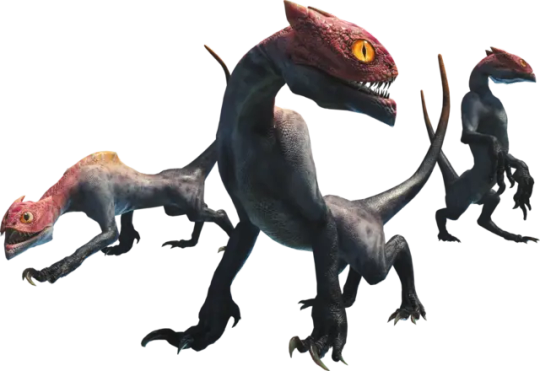
"Reptilian ankle biters."
The Shamos are an interesting breed. Like the Jagras and the Girros, they are small Fanged Wyverns that occupy a part of the New World, in this case the Coral Highlands. But unlike the other two, they don't have a Great leader. They're just weird little scamps that show up every now and then. Bit of a shame, really. A Great Shamos would be interesting to see. 5.5/10.

"Protect at all costs."
The Dodogama all but captured the hearts of everyone who saw it. And I see the appeal! It's a big rotund reptile colored with the appealing hues of a agamid lizard and a massive lower jaw that not only looks way less dumb than, say, the Uragaan's, but also makes it look like it's giving us all the biggest smile! Also, it sounds like a whale. But don't think for a moment that the Dodogama is totally defenseless. Its saliva is incredibly volatile, and when mixed with the rocks it feasts on, they become explosive boulders that it can lob at foes. Gotta say, it's rare you find a monster that manages to be cute and cool at the same time. 8.5/10.
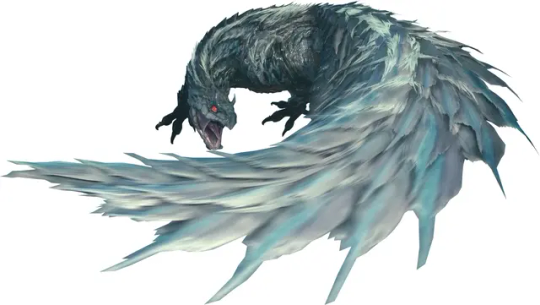
"That's not flying! It's falling with style!"
Monsters that look like snakes are never not going to score big for me, but I really admire the direction they went with the Tobi-Kadachi. It's got the head of a snake (complete with the brow of an eyelash pit viper), but the body plan of, of all things, a flying squirrel. Yes, it can glide. That's already neat, but then you factor in how it can generate static electricity by rubbing itself against everything and then storing that static in special spines across its back. Once again, we have a Fanged Wyvern that goes all-in on out-there creativity, and I love it! 8/10.

"I SMELL BACON!!!"
The deadliest predator in the Rotten Vale that isn't an Elder Dragon, the Odogaron looks like the sort of thing you'd expect in a particularly harrowing tale about eastern demons. It certainly has the look of one, with its tail studded with teeth-like spikes, two sets of claws used to lacerate prey, and mouth full of razor-sharp teeth. All on top of a hide that looks like exposed skin. Yup, it's a demon Gorgonopsid, alright. I should also note that I've always been personally unnerved by how it sounds like a psychotic hound on top of everything. It's fierce, it's fast, it was my first major roadblock while playing World. Props to the homicidal slim jim! 8.5/10.

"And yes, they indeed don't care."
Once again, we have small Fanged Wyverns without a leader. And what's worse is that I LIKE the small ones here, so I'm wondering where the big guy went off to even more. The Wulgs occupy Hoarfrost Reach, and the best way to describe them is "badger wolves". With scythe-like spurs on their front legs. And they can coil around hunters. Yeah, these guys don't let their smallness get in the way of being proficient predators. Should they ever come back, I NEED to see a Great Wulg. It would be awesome, I know it! 7/10.

"Samur-aye aye aye"
The flagship of Rise...how do I feel about Magnamalo? Well, I do like the concept. A massive cat with the horns and fighting style of a dark samurai that produces a deadly purple flame capable of detonating whenever it stays in place for too long. This flame, known as Hellfire, is actually volatile gas produced by the monster's rampant metabolism, and it can be used in a variety of ways. My favorite tactic comes from how the Magnamalo uses its flexible spear-like tail. It can literally wave it around like a wand, summoning homing balls of Hellfire, or even concentrating it all into a quick and huge BLAST of it. The fire itself is based on the Hitodama, which are lights said to surround ghosts in Japanese mythology. But aside from all of that, as well as a pretty cool theme music, Magnamalo isn't really an 8 because I find its design to be maybe just a bit too try-hard and edgy. Plus, it doesn't really affect the plot as much as it would like to say it does. 7/10.
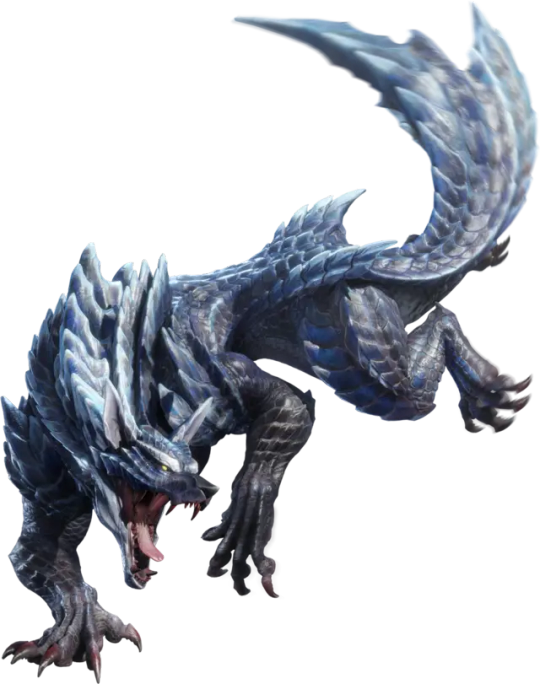
"AH! A wild furry!"
At first, the Lunagaron appears to be totally unimpressive. It's literally just a big wolf with scaly armor and ice powers...until it gets mad. Then, its armor violently extends, it covers its claws and hide with ice, and it rears up on its hind legs. Suddenly, you realize in what way this thing was based on the myth of the werewolf. There's a world of a difference between how striking the Lunagaron is in its base mode and its empowered form, which can slice you to pieces with lightning fast claw strikes. For that, the big dog avoids being average in a big way! 7.5/10.
Well folks, we're on our way to reaching the end here. Our final part will cover the most powerful monsters of all...the Elder Dragons.
Index:
Herbivores
Neopterons, Carapaceans, Temnocerans
Bird Wyverns
Flying Wyverns
Piscine Wyverns, Amphibians, Leviathans
Brute Wyverns
Fanged Beasts, Fanged Wyverns
Elder Dragons
22 notes
·
View notes
Text


Horsfield's tarsier
Bau, Sarawak, Malaysia
Horsfield's tarsier is currently listed as vulnerable by the IUCN, with their population decreasing. They are the smallest primate native to Borneo and are one of the only carnivorous primates, with their diet consisting primarily of insects and small vertebrates. Depending on the location in Borneo, spotting a tarsier could either mean the observer will have a successful headhunt or will be married within a year.
#art#photographers of tumblr#artists of tumblr#photography#beauty#aesthetic#asia#nature#animal#primate#tarsier#ecology#conservation#bau#sarawak#malaysia#mammal monday
16 notes
·
View notes